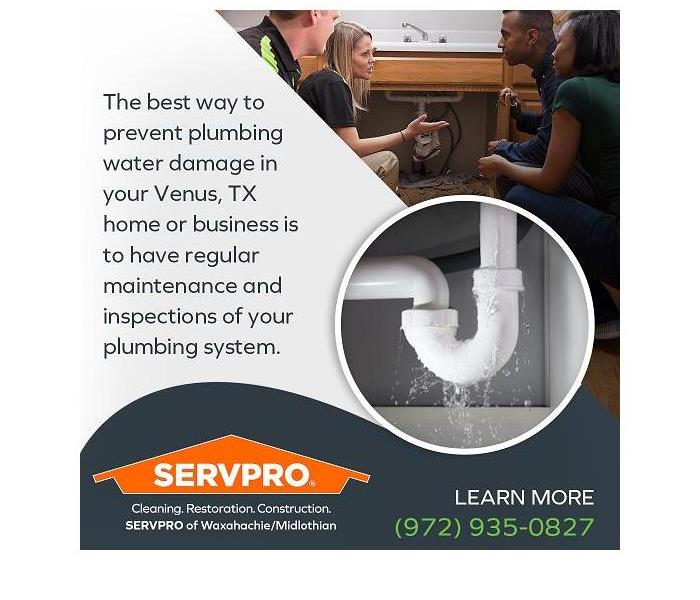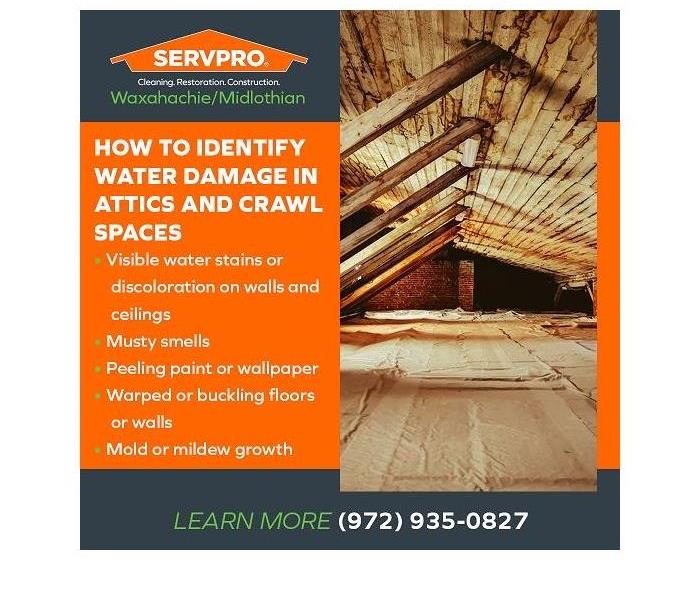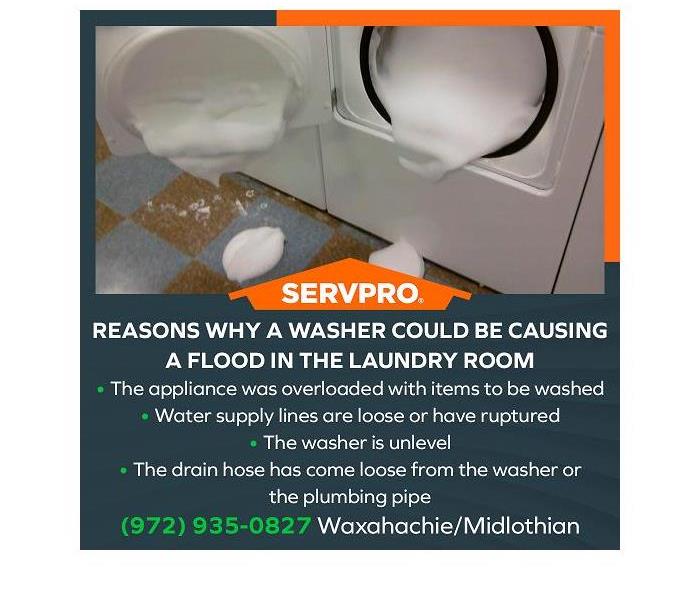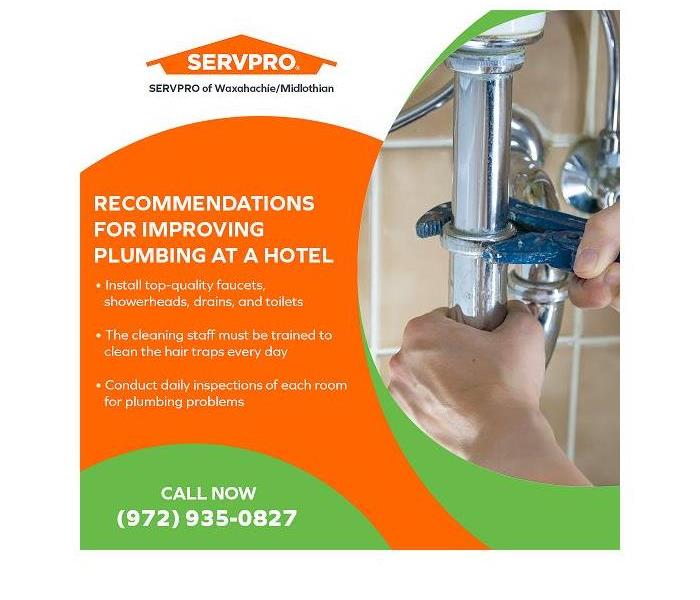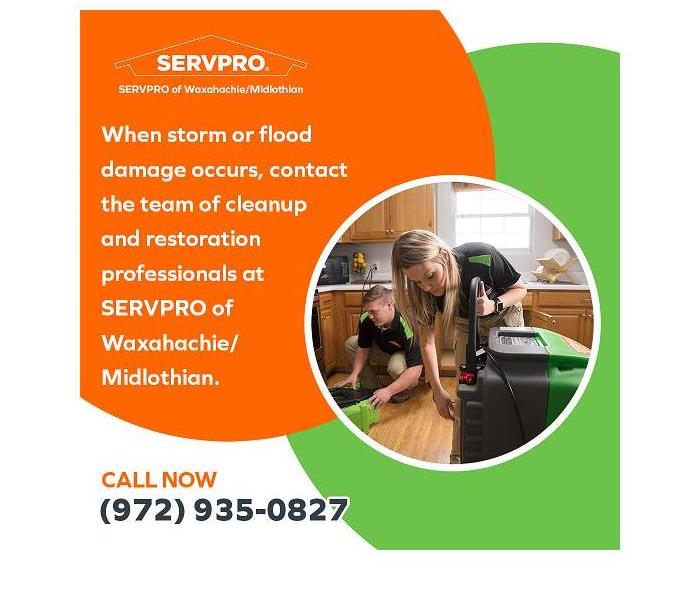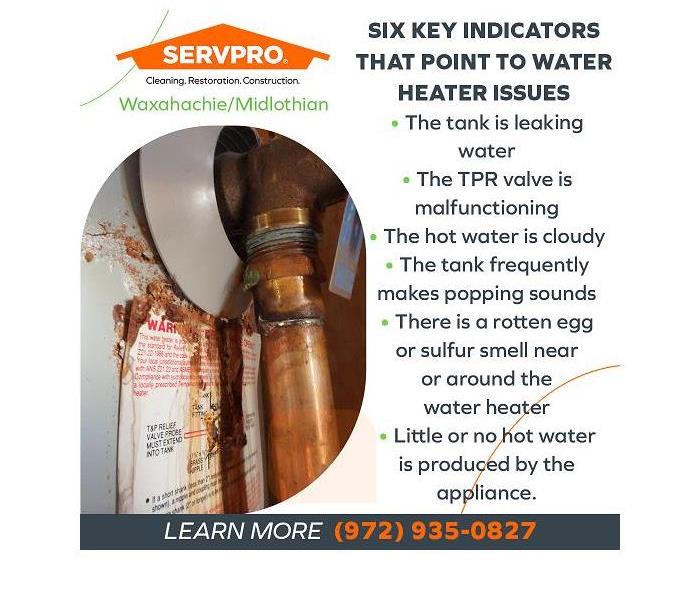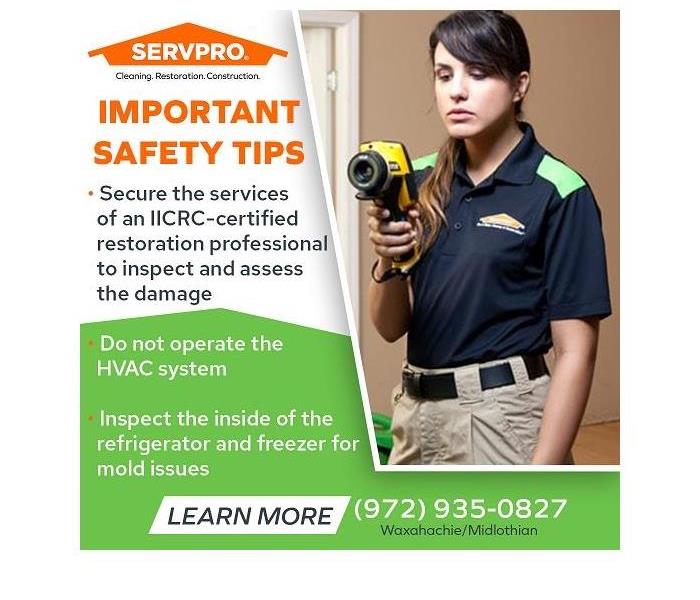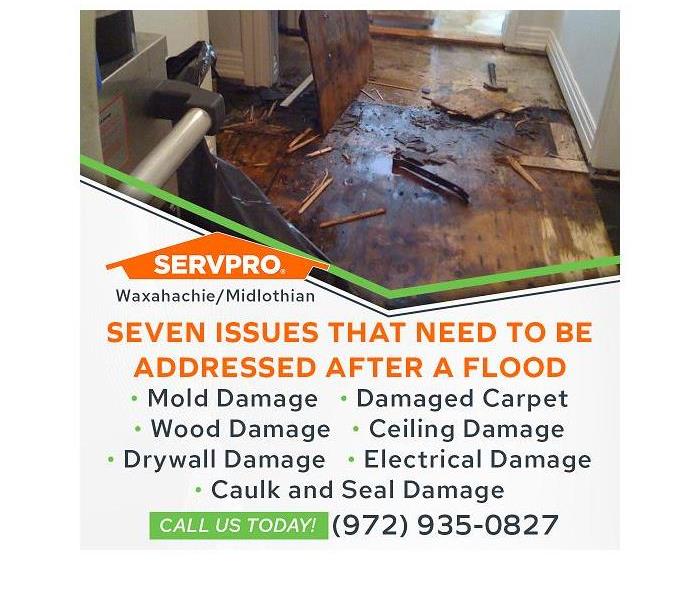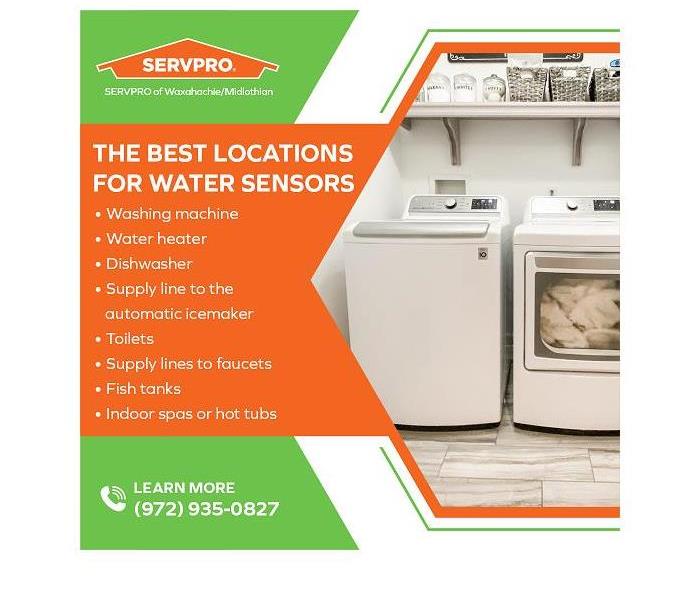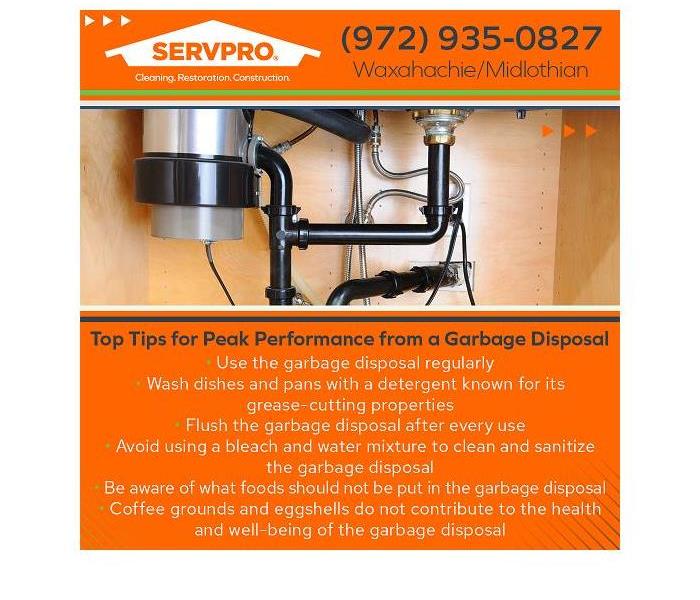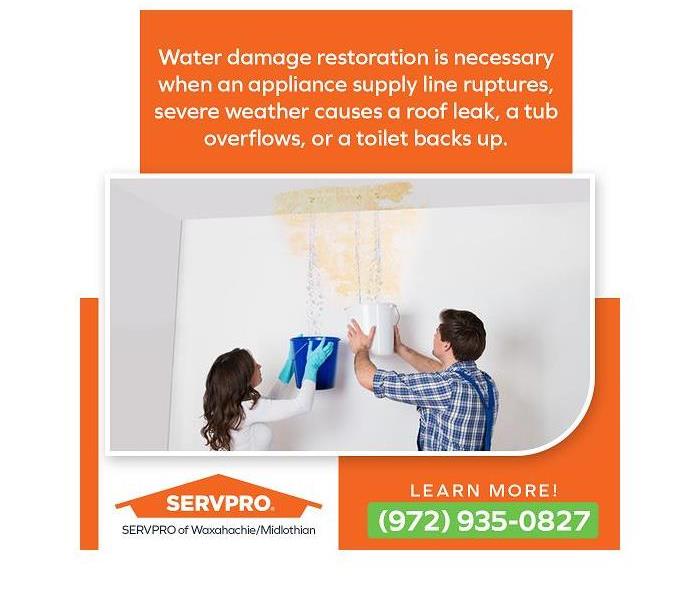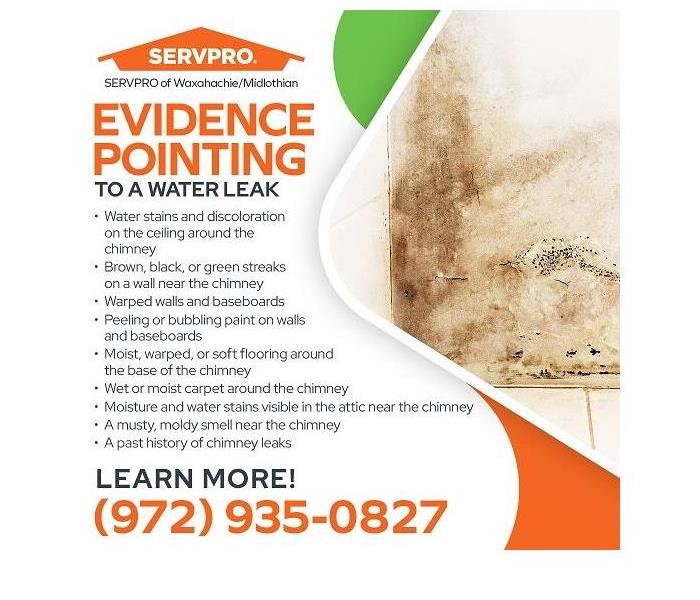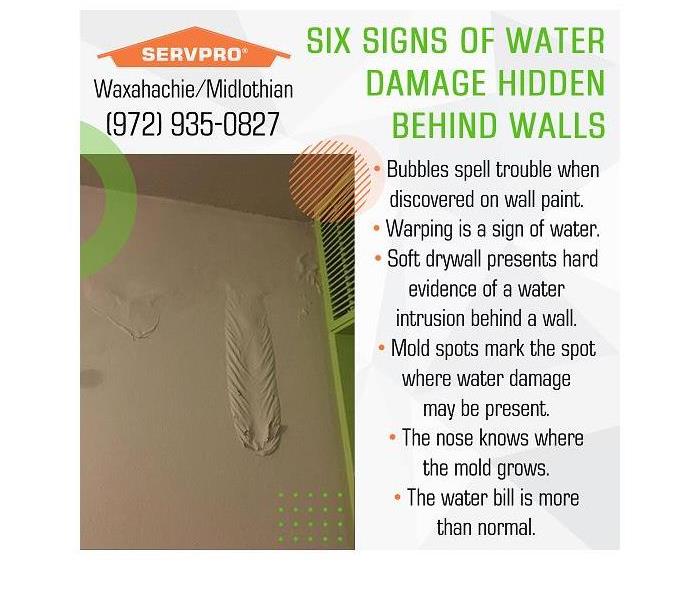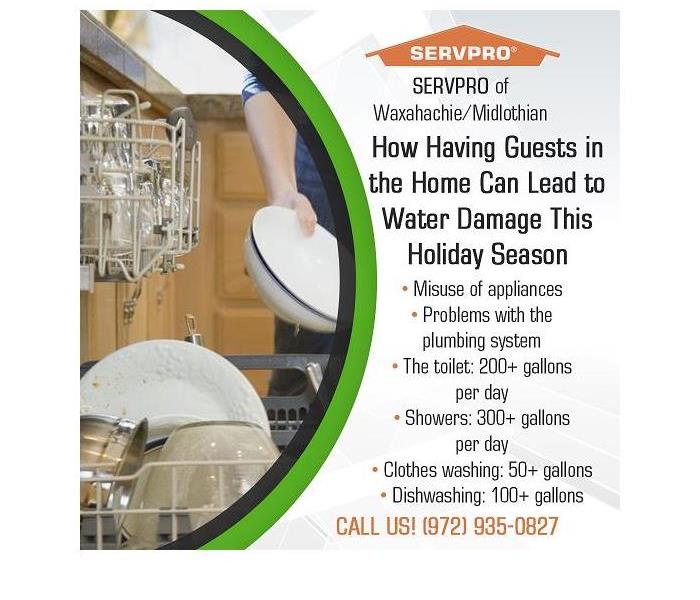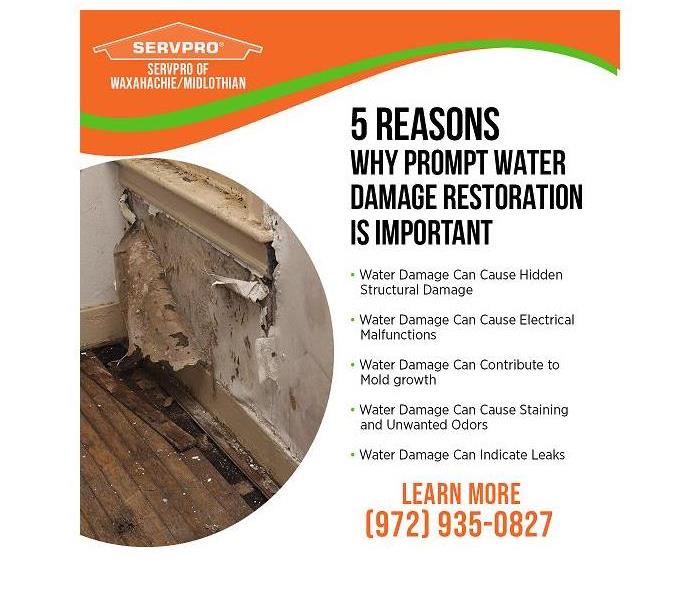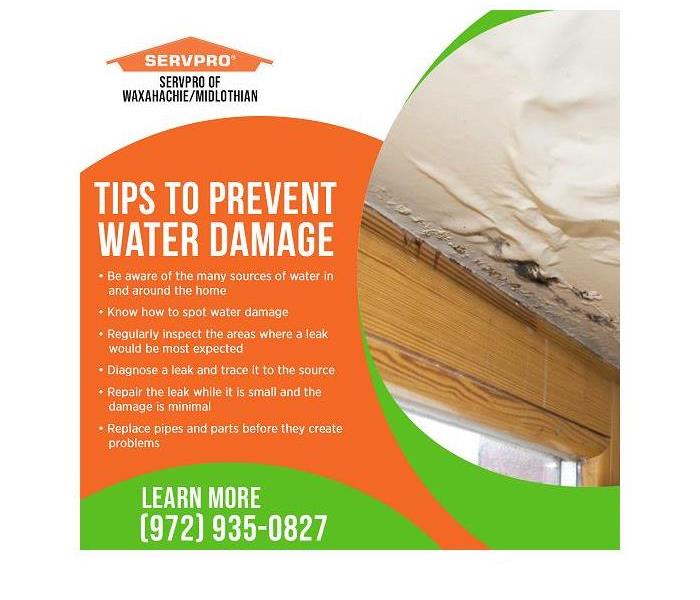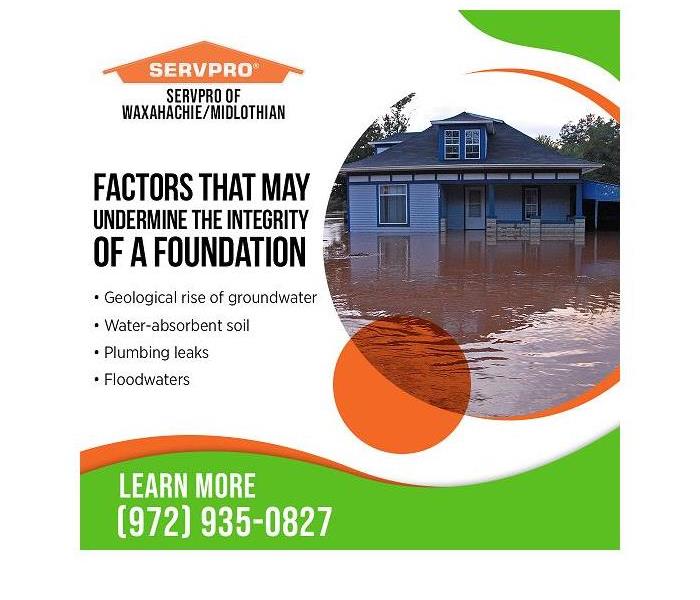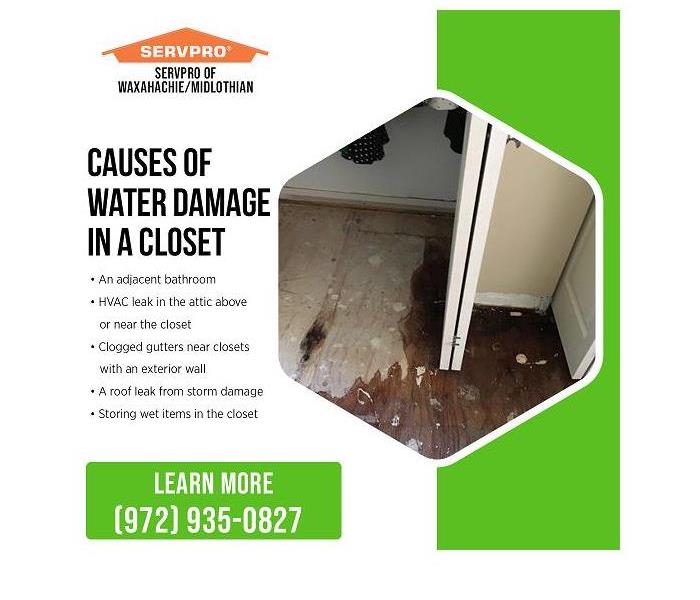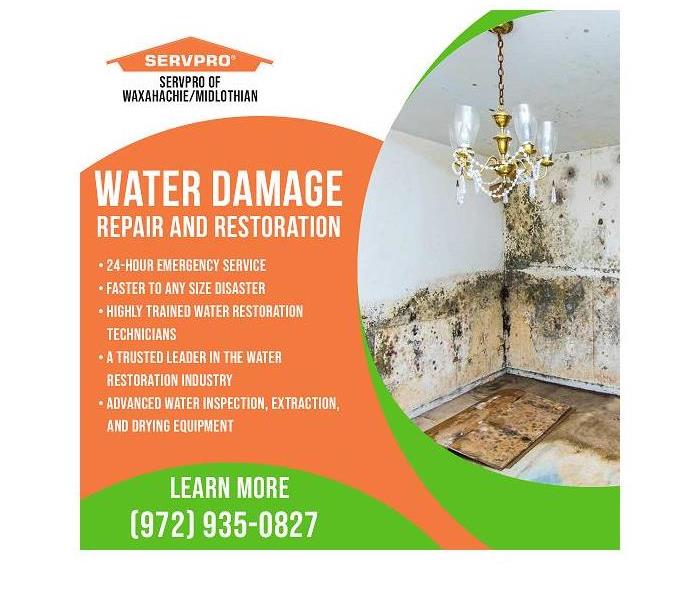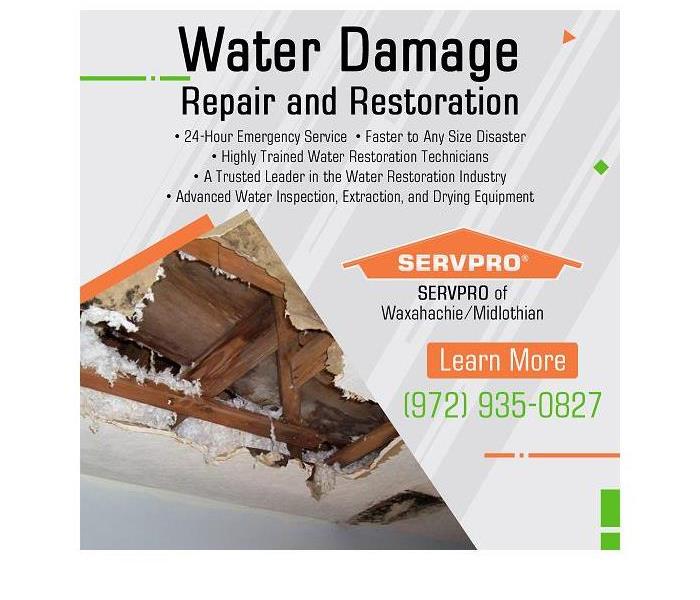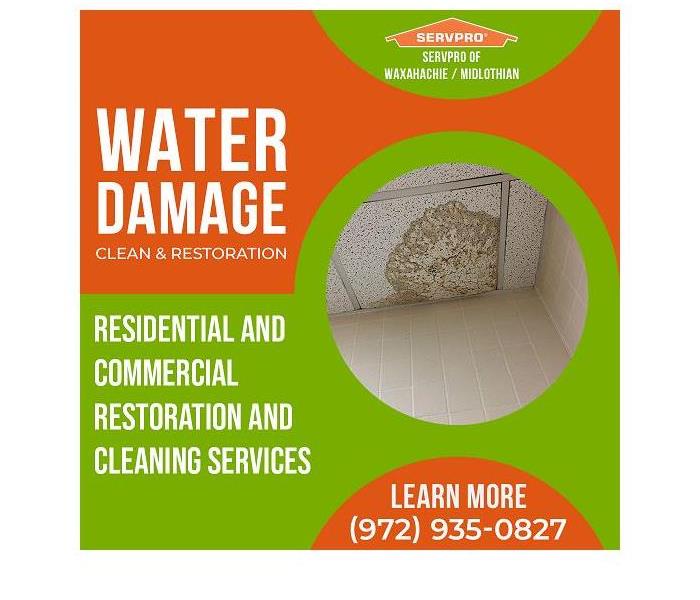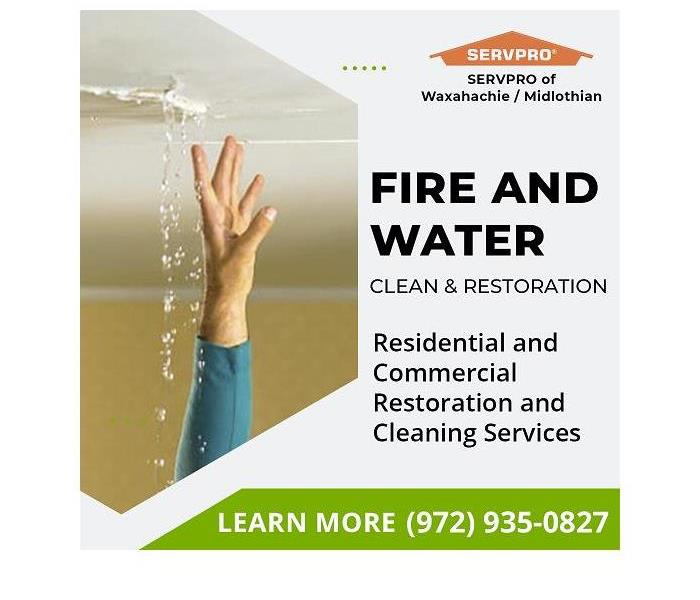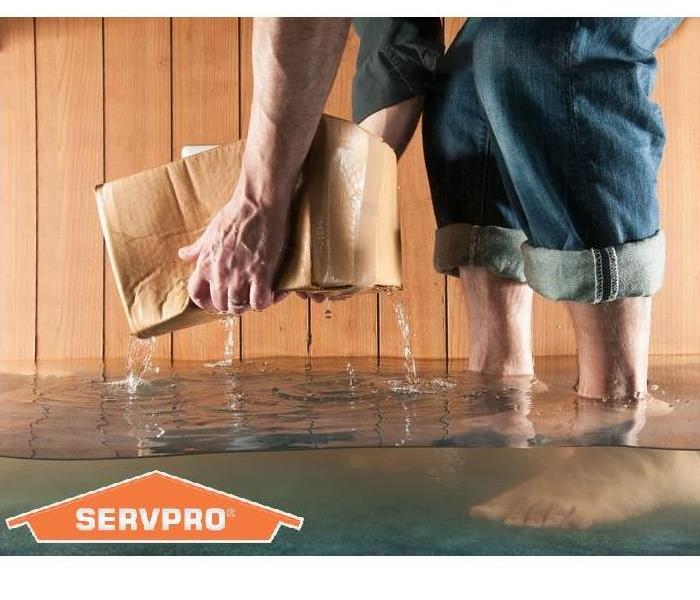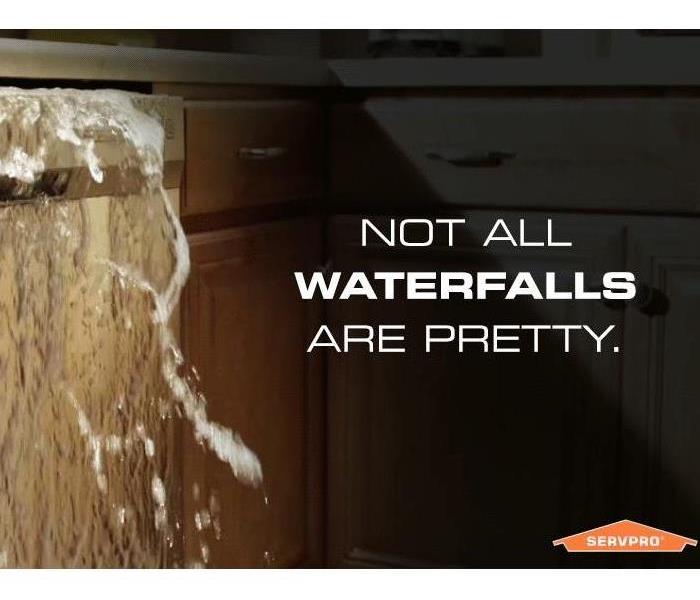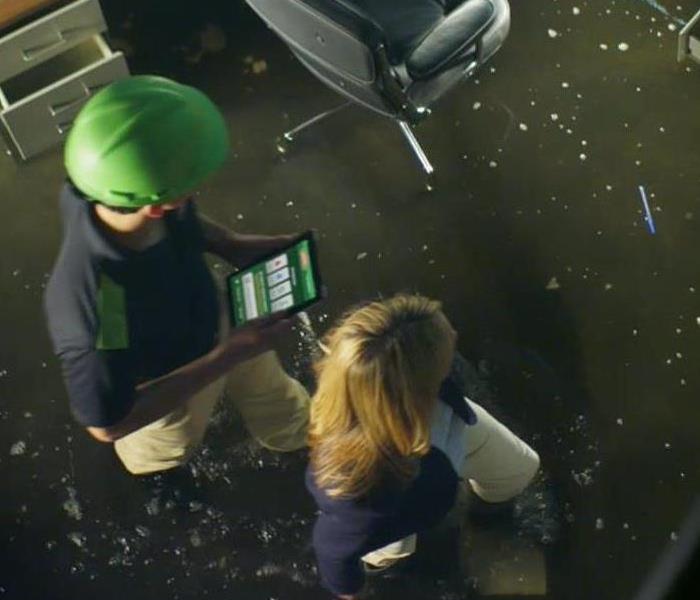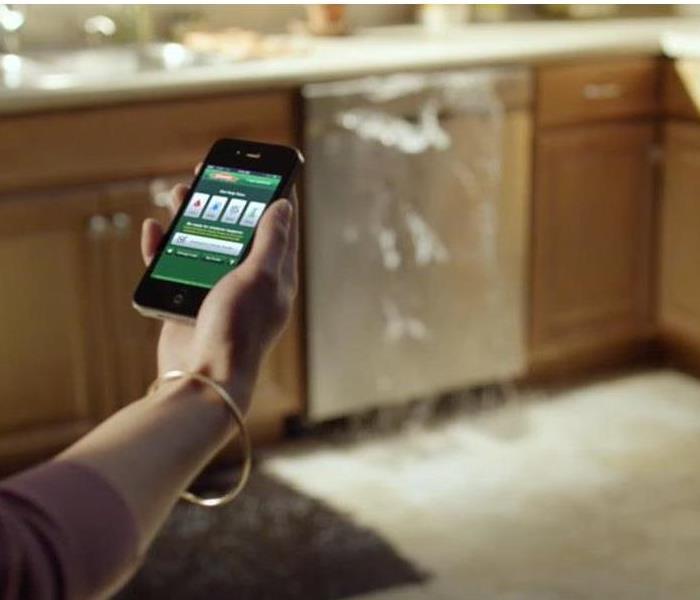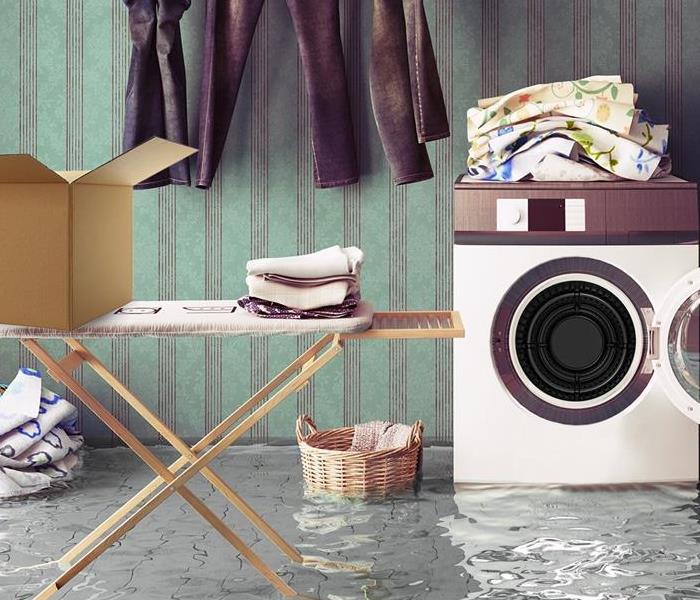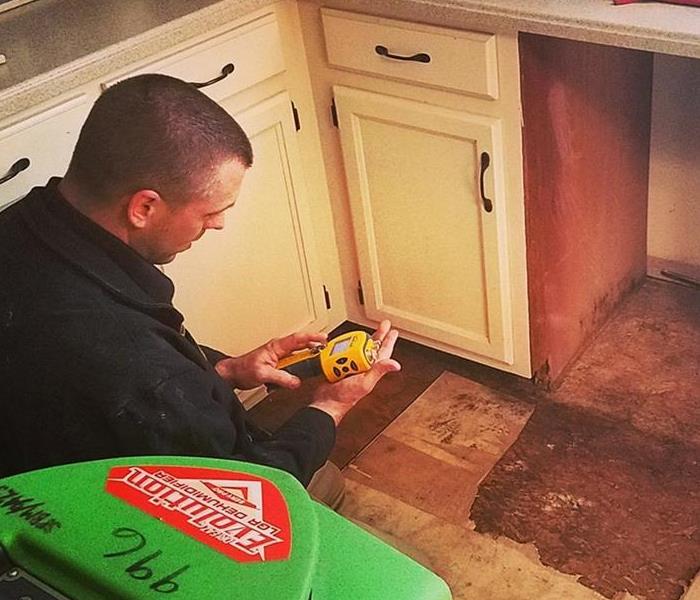Recent Water Damage Posts
SERVPRO of Waxahachie/Midlothian offers water damage restoration services for plumbing-related damages
5/7/2023 (Permalink)
Blog Summary: Many customers have been highly satisfied with the services of SERVPRO of Waxahachie/Midlothian and have recommended their services. To prevent plumbing water damage, it is important to have regular maintenance and inspections of the plumbing system, check for any cracks or leaks, and replace old pipes and fixtures.
SERVPRO® of Waxahachie/Midlothian is a full-service water damage restoration and remediation company that is dedicated to serving the needs of Venus, TX. Their certified and experienced technicians provide top-notch plumbing water damage restoration services that are fast, efficient, and cost-effective. The team understands the urgency of restoring a property after a flood or water-related emergency and is available 24/7 to respond.
Common causes of plumbing-related water damage in Venus, TX
Plumbing water damage in Venus, TX, can be caused by a variety of issues, including broken pipes, overflowing toilets, leaking appliances, and sewer backups. In certain cases, plumbing water damage can cause extensive damage to the structure of a home or business. To avoid such issues, knowing the common causes of plumbing water damage is important.
Steps in the plumbing-related water damage restoration process
SERVPRO of Waxahachie/Midlothian’s team of experienced technicians can handle any plumbing water damage restoration project. The process begins with assessing the damage and a plan of action. Then, professional-grade equipment is used to remove the water and moisture from the affected areas. Specialized techniques are also used to dry and dehumidify the area and restore it to pre-damage condition.
Testimonials from Satisfied Customers in Venus, TX
Many customers in Venus, TX, and nearby areas have used SERVPRO of Waxahachie/Midlothian’s plumbing water damage restoration services and have been highly satisfied with the results. Here is what some of them have to say:
“I am a Texas real estate agent in the DFW area, and I have always recommended SERVPRO of Waxahachie/Midlothian to my clients… My clients have always thanked me for the recommendation… I highly recommend Addison Carey and his team!” – Donna in Mansfield, TX.
“Mine and my son's house flooded from Tropical Storm Imelda, and ya'll came all the way over there to help us. Everyone was so nice and courteous. The guys went over and beyond helping us. God sent us some angels those days they were there.” – Vanessa in Vidor, TX.
Frequently asked questions about plumbing water damage restoration
Q: What is the best solution for plumbing-related water damage?
A: The best solution for plumbing-related water damage is to contact a professional water damage restoration company like SERVPRO of Waxahachie/Midlothian. Their technicians are trained to handle any plumbing water damage restoration project, and they use the latest tools and techniques to restore your property to pre-damage condition.
Q: How long does it take to restore plumbing-related water damage?
A: The amount of time it takes to restore plumbing-related water damage depends on the severity of the damage. However, SERVPRO of Waxahachie/Midlothian’s technicians are trained to work quickly and efficiently to minimize the disruption to your home or business.
How to prevent plumbing-related water damage in your Venus, TX home or business
The best way to prevent plumbing water damage in your Venus, TX, home or business is to have regular maintenance and inspections of your plumbing system. Additionally, check for any cracks or leaks and repair them immediately. Old pipes and fixtures should also be replaced. Finally, keep an eye out for any signs of plumbing water damage, and contact a professional water damage restoration company if you suspect any damage.
Contact SERVPRO of Waxahachie/Midlothian for water damage restoration needs
SERVPRO of Waxahachie/Midlothian is a full-service water damage restoration and remediation company serving the needs of Venus, TX, and surrounding areas. Their certified technicians provide top-notch plumbing water damage restoration services that are fast, efficient, and cost-effective. The team understands the urgency of restoring a property after a flood or water-related emergency and is available 24/7 to respond to such emergencies.
For more information or to schedule an appointment, please contact SERVPRO of Waxahachie/Midlothian at (972) 935-0827 or visit their website at https://www.SERVPROwaxahachiemidlothian.com/.
SERVPRO of Waxahachie/Midlothian offers tips to identify and treat attic and crawl space water damage
4/11/2023 (Permalink)
Blog Summary: Water damage in attics and crawl spaces, can be caused by poor ventilation, clogged gutters, and leaking pipes, and can be difficult to detect. SERVPRO of Waxahachie/Midlothian provides effective solutions to remove the water and restore the area to its pre-damaged condition.
Midlothian, TX – SERVPRO® of Waxahachie/Midlothian offers professional water damage restoration services for attics and crawl spaces in Midlothian and the surrounding areas. The company has been providing reliable and timely services for over 25 years and has earned a reputation for quality and excellence.
Water damage in attics and crawl spaces is a common problem for many homeowners in Midlothian and the surrounding areas. This type of water damage can be caused by a variety of factors, including poor ventilation, clogged gutters, and leaking pipes. Poor ventilation can trap moisture in the air, leading to water damage over time. Clogged gutters can cause water to overflow and seep into the attic or crawl space while leaking pipes can cause water to accumulate in the area. SERVPRO of Waxahachie/Midlothian helps homeowners identify the source of the water damage and provides effective solutions to restore the area to its pre-damaged condition.
How to identify water damage in attics and crawl spaces
Water damage can be difficult to detect in attics and crawl spaces because it is often hidden from view. However, there are several signs that homeowners should look for to identify water damage in these areas:
- Visible water stains or discoloration on walls and ceilings
- Musty smells
- Peeling paint or wallpaper
- Warped or buckling floors or walls
- Mold or mildew growth
Steps to follow when you suspect water damage in attics and crawl spaces
- Visually inspect the area for signs of water damage, such as water stains, musty smells, peeling paint/wallpaper, warped/buckling floors/walls, and mold/mildew growth.
- Identify the source of the water damage and take measures to stop it.
- Contact a professional water damage restoration service right away.
- Follow the directions of the water damage restoration technicians.
- Allow the technicians to dry, dehumidify, and sanitize the affected area.
- Repair any structural damage and re-insulate the area to prevent future water damage.
If you notice any of these signs of water damage in your attic or crawl space, it is important to contact a professional water damage restoration service right away.
SERVPRO of Waxahachie/Midlothian: professional water damage restoration services
SERVPRO of Waxahachie/Midlothian offers professional water damage restoration services to help homeowners repair and restore their attics and crawl spaces. The company’s experienced technicians use specialized equipment and techniques to quickly and effectively remove water and moisture from the affected area.
Once the water is removed, SERVPRO of Waxahachie/Midlothian can help homeowners repair and restore their attics and crawl spaces. The company’s technicians can dry, dehumidify, and sanitize the affected area to prevent further damage and mold growth. They can also repair any structural damage and re-insulate the area to ensure that it is properly sealed and protected against future water damage.
SERVPRO of Waxahachie/Midlothian is committed to providing the highest quality services to its customers. The company is certified by the Institute of Inspection Cleaning and Restoration Certification (IICRC), and its technicians receive regular training to stay up to date on the latest restoration techniques and technologies.
Contact SERVPRO of Waxahachie/Midlothian for professional water damage restoration services
If you are experiencing water damage in your attic or crawl space, contact SERVPRO of Waxahachie/Midlothian for professional water damage restoration services. The company’s experienced technicians can quickly identify the source of the water damage and provide effective solutions to restore the area to its pre-damaged condition.
For more information about SERVPRO of Waxahachie/Midlothian’s water damage restoration services, visit their website at https://www.SERVPROwaxahachiemidlothian.com/ or call (972) 935-0827. You can also email them at acarey@SERVPRO10932.com or fill up the contact form for water damage restoration services in Venus, TX, and surrounding areas.
Flood restoration services - the best course of action when the washing machine floods the laundry room
3/13/2023 (Permalink)
Blog Summary: SERVPRO of Waxahachie/Midlothian highlights four reasons why the washing machine could flood the laundry room and explains how to handle the water damage.
SERVPRO® of Waxahachie/Midlothian provides flood restoration services and water damage cleanup for clients in Venus, TX. Whether the water is from a flash flood or a leaking washing machine, the team of IICRC-certified technicians can handle it with a rapid response and quick cleanup to get life back to normal as soon as possible.
A washing machine is an essential appliance in the home. When the washer malfunctions or breaks, the flooded laundry room can be very frustrating and stressful to deal with. The water-damaged floor needs to be rapidly restored to prevent water damage to the floor coving, substrate, baseboards, and items on the floor that might have received water damage. Here are the four most common reasons a washing machine floods the laundry room.
#1. Overloading the machine
With life so busy, the temptation is to fill the washer to full capacity to reduce the number of loads and save time and effort. When the machine is overloaded, the garments being washed can become lodged around the agitator or in the drum, and water could spill onto the floor.
Bulky items like heavy coats, bedspreads, blankets, thick towels, small runners or area rugs, and bathroom mats can quickly overload the appliance. Wash fewer bulky items at a time to reduce strain on the machine and prevent the drum from overflowing and flooding the laundry room. A full load weighs about 20-25 pounds, or about the same weight as three gallons of milk. Be aware that a load of lightweight, fluffy items may fill the drum well before reaching the appliance’s weight capacity. Be sure to read and follow the manufacturer’s instructions. Proper operation and maintenance can extend the machine's life and help keep the laundry room floor dry and safe.
#2. Faulty or ruptured water supply lines
The hot and cold supply lines should be securely attached to the washer and the water sources. If the connections are leaky, the gaskets inside might need replacement. If the hoses are more than five to seven years old, consider replacing both hoses before they rupture. A supply line can leak seven to nine gallons of water per minute. At this rate, a flooded laundry room turns into a flooded home. High-quality, braided stainless steel connector hoses are recommended. The additional expense is worth the extra layer of security and peace of mind.
#3. The washer is unlevel
The laundry room might be flooded because the washer is unlevel or out of balance. The appliance should be leveled when installed and then checked periodically with a level if the machine begins to wobble and walk during the spin cycle. Check the level of the floor to make sure it has not shifted. The appliance can be leveled by adjusting the small feet on the bottom of the unit.
If the machine and the floor are level, the problem might be an imbalanced load. Solve the problem before flooding occurs by re-positioning the clothes in the drum. Resume the washing cycle to determine if the efforts were successful. If not, try again or remove some clothes from the washer. The issue might be the drum is overloaded.
#4. Faulty drain hose connection to the plumbing pipe
The hose runs from the washer to a plumbing pipe next to the washer. Almost 20 gallons of water will flood the laundry room if the hose comes loose from a standard washer. Periodically check the connections and hoses for leaks.
#5. Mechanical failure
Aside from the issues mentioned above that cause washing machines to flood the laundry room, mechanical failures may also result in a water release flooding the laundry space. These include:
- Solenoid failing to shut off the water flow into the washer.
- The water inlet valve becomes blocked by debris.
- Debris lodges in the pump.
- A faulty water level control valve fails to shut the machine off.
- The drain pump wears out or breaks.
What to do when the laundry room floods
A small leak can easily be cleaned up by the homeowner. However, a significant water release needs immediate attention and a quick cleanup using powerful wet/dry vacuums to extract the water. Heavy-duty dehumidifiers and rapid-spin fans remove excess moisture. SERVPRO of Waxahachie/Midlothian is available 24/7, 365 days a year, including holidays, to provide the quick cleanup and restoration that a flooded laundry room or an entire home needs.
For more information about flood damage cleanup, contact SERVPRO of Waxahachie/Midlothian by phone at (972) 935-0827 or email at acarey@SERVPRO10932.com.
Water Damage Restoration for Hotels That Sustained Water Damage Due to Plumbing Problems
2/8/2023 (Permalink)
Blog Summary: SERVPRO of Waxahachie/Midlothian serves the hotel industry by providing water damage restoration services when plumbing issues cause water damage.
SERVPRO® of Waxahachie/Midlothian specializes in water damage restoration services when hotel plumbing issues cause a water damage disaster. Trained technicians can also tackle fire damage, smoke damage, and storm damage cleanup and restoration.
Hotel managers and owners in Ovilla, TX, understand the challenges of making each guest’s stay a warm and satisfying experience. Every detail must be perfect. Plumbing is a top priority, including considerations such as the guest’s bathroom, the in-room kitchen, pool, spa, restaurants, bars, landscaping, sprinklers, and fire sprinkler system. The smallest plumbing glitch could quickly turn into a cascade of issues negatively impacting every facet of the customer’s experience. Hotel managers and owners can stay out in front of plumbing issues by taking a proactive approach that anticipates problems, finds solutions, and implements changes before an issue spirals out of control.
Resolve inadequate plumbing
A poorly designed plumbing system is impossible to overcome without a major overhaul. The best maintenance schedule and vigilance in solving isolated problems will not resolve the larger issues stemming from design and installation flaws. Generally, hotels are adequately equipped to manage plumbing needs at basic daily occupancy. Special occasions such as concerts, conferences, or conventions create periods where full occupancy is the norm. Many, if not all, of the guests, share an almost identical schedule for showering in the morning and possibly again in the evening. The plumbing system should be designed to handle maximum capacity day in and day out without fail. If the plumbing design has an insufficient load capacity engineered into the system, a disaster looms every time the guests click on the “no vacancies” sign.
The commercial venue plumbing must accommodate most of the occupants taking a shower and flushing the toilet simultaneously or within a narrow window of maximum usage. The water temperature in every shower should meet the demands of each customer, and the water pressure should be strong and uniform for every room.
Cold, weak showers, coupled with systemic sewage backups, have catastrophic consequences for a local hotel. A multi-floor water damage disaster could result from a burst pipe, and a sewage backup or toilet overflow could affect multiple rooms and multiple floors of the hotel. The disaster could generate a surge of negative reviews, which could wreck profits.
Code compliance for hotels in the area of plumbing is an absolute necessity. If there is any doubt regarding the facility’s compliance with health standards and building codes, conduct internal inspections or hire a third-party contractor to assess the system and provide a report. The findings are a solid step in the right direction. Stay on track with regular inspections: schedule repairs and upgrades.
Even if the hotel and plumbing are dated, adjustments, upgrades, and repairs can be implemented incrementally to accommodate occupancy levels, budgets, and long-term plans for the hotel and the market. Also, installing a more efficient plumbing system can eliminate leaks and conserve water usage, yielding a solid ROI.
Begin with the bathrooms
While some plumbing issues can be resolved behind the scenes because the impact does not affect guest accommodations, plumbing problems in a guest’s bathroom rarely go unnoticed. A sewage backup or toilet overflow creates a negative customer experience.
Consider the following recommendations for improving plumbing at these touch points in the guest’s journey with the hotel:
- Install top-quality faucets, showerheads, drains, and toilets. Drains and toilets should be free-flowing and clog-resistant. Better quality, high-efficiency, low-flow fixtures will not compromise the user’s experience.
- Adding hair traps to drains will eliminate clogged sinks, tubs, and showers. The cleaning staff must be trained to clean the hair traps every day without fail.
- Conduct daily inspections of each room for plumbing problems. Even if guests are planning to enjoy an extended stay, the room receives a daily once-over for plumbing issues when it is being cleaned. The checklist may include the following tasks:
- Check for leaky faucets and showerheads.
- Visually inspect the plumbing under the sink for joint and connection leaks. If possible, touch connections to detect unexplained moisture. Look for stains, warping, peeling paint, and wallpaper bubbling or separating from walls.
- Clean drains and observe drainage rates.
- Observe the water pressure when cleaning sinks, bathtubs, and showers.
- Conduct a sniff test for musty, mildewy smells, which may indicate hidden leaks and mold growth.
Make reporting plumbing issues simple, fast, and easy. Reward the consistent performance of inspection duties.
Water damage restoration for hotels
Locally owned and in business since 2000 and backed by a nationwide system of qualified franchises, SERVPRO of Waxahachie/Midlothian can scale to meet any size disaster. IICRC-certified technicians arrive on-scene in less than an hour to begin the water damage cleanup and restoration process, which is crucial for hotels. Available 24/7, 365 days a year, including holidays, SERVPRO of Waxahachie/Midlothian utilizes the latest equipment, cutting-edge technology, advanced cleaning techniques, and EPA-approved cleaning products.
For more information about water damage restoration in Ovilla, TX, email SERVPRO of Waxahachie/Midlothian at acarey@SERVPRO10932.com or call (972) 935-0827.
The dangers of a water-damaged water heater and how to recover when a water heater floods the home
1/25/2023 (Permalink)
Blog Summary: SERVPRO® of Waxahachie/Midlothian recommends homeowners replace flood-damaged water heaters. The water removal services of a certified, experienced damage restoration company are indispensable for the cleanup and restoration process.
As a leader in the restoration industry, SERVPRO of Waxahachie/Midlothian helps homeowners understand how flooding can damage a water heater and how to secure the water removal and damage restoration services needed to recover from the disaster.
The water heater and flood damage
When a water heater is damaged in a flood, the homeowners will wonder if the appliance can be salvaged. If it cannot be salvaged, the water heater should be removed, discarded, and replaced with a new one. A wrong course of action in this situation could lead to serious consequences, including electrical shock, a fire, or another water damage disaster caused by the faulty water heater.
Experts from the Air-Conditioning, Heating and Refrigeration Institute (AHRI) recommend that a flood-damaged water heater be replaced, not repaired. A flooded home or basement exposes a water heater to partial or complete submersion in water, causing catastrophic failure of the water heater. In the event of a flood, homeowners must exercise caution. Safety, not salvaging the water heater, is the top priority. Any electrical device, no matter how large or small, should receive careful attention before being used. This attention includes inspection, drying, cleaning, repairs, and cautious testing by a licensed and experienced technician.
To prevent any personal injury, damage to the electrical system of the house, or potential fire, avoid using any appliances receiving any water damage. This principle applies to all water heaters: gas, electric, and oil.
The valves and controls on a gas unit are vulnerable to corrosion damage, and the thermostats and controls in an electric water heater will also suffer from corrosion. The metal skin of the water heater is not entirely waterproof. The insulation surrounding the tank will be water-logged with contaminated flood water and will prove challenging to dry out and nearly impossible to disinfect.
Installation of a new water heater
Entrust the inspection and replacement of flood-damage appliances such as the water heater to qualified professionals. The homeowner can save money long-term by replacing the old water heater with a new high-efficiency model.
Make sure the Temperature and Pressure (TPR) valve is replaced along with the water heater; if the TPR valve is exposed to flood water, the risk of malfunction increases. A failed TPR can have catastrophic consequences for a home and its occupants.
For gas-fired water heaters, ensure that the gas line has not been crimped, mashed, or cut during the flood. The line should be purged to remove moisture, water, or dirt. For best results and to ensure the safety of the home’s residents, have a licensed, bonded, and insured professional handle all aspects of the new installation, including purging or replacing the gas line.
How to deal with the flood damage in the rest of the home
When flooding from a flash flood, a burst pipe, or storm damage occurs, secure the services of a professional property damage cleanup and restoration company to handle the job. Rapid response and quick cleanup can help return life to normal while reducing the risk of advanced secondary damage from prolonged exposure to water and moisture. Powerful pumps and wet/dry vacuums can rapidly remove any excess water from the home or basement. High-capacity dehumidifiers quickly and efficiently dry out the remaining moisture, which, if left unchecked, can cause a mold infestation.
SERVPRO of Waxahachie/Midlothian, a locally owned and operated company, has experienced, trained, and IICRC-certified technicians who utilize cutting-edge moisture-detecting technology and advanced cleaning techniques. The EPA-approved cleaning products are safe for pets and humans. The detailed and well-documented estimate provides vital information needed for the insurance claims process, which SERVPRO of Waxahachie/Midlothian can handle from beginning to end. Flood waters are often contaminated with toxic chemicals and pathogens from raw sewage. The SERVPRO technicians take every precaution to ensure their safety and the safety of the occupants of the home.
The best time to find a qualified property damage cleanup and restoration company is before a fire, smoke, or water damage disaster. Nobody wants to be calling around for a restoration company at 11:00 pm on the weekend while sewage is backing up in the shower, bathtub, and sinks. By pre-qualifying with SERVPRO of Waxahachie/Midlothian, the homeowner only has to make one call in the event of a disaster. A crew will be on the scene in about an hour or two to begin the cleanup and restoration process.
For more information about Midlothian, TX, water removal services, call SERVPRO of Waxahachie/Midlothian at (972) 935-0827 or email acarey@SERVPRO10932.com.
Why SERVPRO of Waxahachie/Midlothian is the restoration company to call when a water heater bursts
1/11/2023 (Permalink)
Blog Summary: SERVPRO® of Waxahachie/Midlothian highlights six signs that a water heater is having problems that could lead to the rupture of the unit and water damage.
The fire and water damage restoration experts at SERVPRO of Waxahachie/Midlothian have experience dealing with many different property damage situations. In the event of a burst water heater, Midlothian, TX, homeowners can turn to SERVPRO of Waxahachie/Midlothian to provide water damage restoration and cleanup services. To help homeowners avoid the disruption, inconvenience, and expense of having to deal with a burst water heater, SERVPRO of Waxahachie/Midlothian highlights key indicators there may be a problem with the water heater.
Six key indicators that point to water heater issues
1. The tank is leaking water
One of the primary indicators that a water heater is in distress is water leaking from the unit. Identifying the leak will require a visual inspection if the appliance is seated in a pan with an evacuation pipe. Leaks usually start small and increase over time. Upon discovering a leak, shut off the appliance’s power and water supply. Immediately contact a reputable plumber to install a new water heater. For any water damage cleanup and restoration needs, contact a reliable and trusted property damage restoration company. Delays in removing any standing water and drying out affected areas could lead to mold infestation.
2. The TPR valve is malfunctioning
The TPR valve prevents the water heater from exploding by releasing excessive pressure. The buildup of rust and corrosion may cause high temperatures and increase pressure. A malfunction in the TPR valve may cause the water heater to explode. The homeowner should test the valve about once a year. Schedule a plumber to conduct the test and inspect the unit if needed.
3. The hot water is cloudy
The water heater may be in distress if the water is cloudy and has a metallic taste and odor. Mineral deposits may be the issue, which can impede the unit's normal function. An orange or red tint to the water signals that the tank and pipes are rusting. If the problem persists, contact a plumber for a diagnosis and remedy.
4. The tank frequently makes popping sounds
Hard water and the buildup of mineral deposits cause the appliance to produce cracking, rumbling, and popping sounds. Request that a plumber inspects the situation. Flushing the unit may resolve the issue.
5. There is a rotten egg or sulfur smell near or around the water heater
A gas-powered water heater may emit a rotten egg or sulfur odor, which indicates a gas leak in the line feeding the unit. In this case, shut off the gas line immediately. Contact a plumber to schedule an inspection and repairs.
6. The appliance produces little or no hot water
The buildup of mineral deposits or the failure of an element may explain why the water heater is not performing well. A plumber can diagnose the failure of a component and replace it. Annual flushing will take care of sediment buildup. The installation of a water conditioning system can remedy hard water issues. If left unresolved, these issues could result in a catastrophic failure of the unit and a major water damage disaster.
Who to call if the water heater bursts and causes water damage
SERVPRO of Waxahachie/Midlothian has been serving the area since 2000. They are locally owned and backed by a nationwide system of qualified franchises. Being centrally located in Ellis County means they are within a thirty-minute drive or less of any location in the community. The team specializes in residential, commercial, and large-scale disaster cleanup and restoration.
One of the many satisfied customers of the water damage restoration company provided the following positive review: “Cody and his crew were amazing! They came to our home in the middle of the night when our water heater burst. They immediately contained the issue, extracted the water, and set up fans to begin the drying process. They checked with me daily to ensure things were drying as expected and kept me informed throughout the process. I cannot recommend SERVPRO enough. Thanks to their quick response and thorough work, they’ve earned a customer for life.”
Contact SERVPRO of Waxahachie/Midlothian for more information about fire and water damage restoration services. The office can be reached by email at acarey@SERVPRO10932.com or by phone at (972) 935-0827.
What to Do When Appliances Have Been Affected by a Water Damage Disaster
10/10/2022 (Permalink)
Blog Summary: SERVPRO of Waxahachie/Midlothian advises homeowners on how to deal with appliances suffering from water damage safely.
SERVPRO® of Waxahachie/Midlothian understands the headaches that water damage can cause. Water damage is not only disruptive and inconvenient, but it can also be dangerous when electrical appliances are involved. Most homes have multiple electrical devices in every room. When these devices are exposed to high levels of moisture or become submersed in water, the risk hazard of shock, electrocution, or fire is elevated.
Below are just a few of the electrical hazards in certain rooms of the home:
- Bathroom: hair dryer, radio, electric clippers, curling iron, fan, portable lamps, cosmetic mirrors
- Kitchen: coffeemakers, blender, food processor, juicer, air fryer, toaster, microwave oven, television
- Laundry room: iron, washer, dryer, floor fan, vacuum cleaner, and freezer
- Home office: computers, monitors, laptop, printers, paper shredder, electric pencil sharpener, fans, recharging station for electronics
How to deal with water-damaged appliances
When entering the home, avoid using any appliances (electric or gas) without first taking necessary safety precautions. The homeowner’s first reaction after a water damage disaster or weather-related flooding may be to venture into the home and assess the extent of the damage. Avoid this impulse. The contents of the house may have shifted, damaging gas lines, electrical wiring, and outlets. The risk is very high. High water may have ripped gas-operated appliances (oven, water heater) from the supply lines. A rotten-egg smell is a strong indication that natural gas is leaking into the home. If a gas leak is detected, immediately evacuate the structure and call 911. Keep everyone a safe distance from the house until the danger is averted.
Moisture and water can quickly render appliances and the HVAC system useless and dangerous. In the case of electrical appliances, the severity of the situation depends on several factors:
- Extent of exposure
- Length of exposure
- Contamination levels from sewage or mold
Important safety tips to keep everyone safe
The safety steps listed below can help families and pets navigate a water damage disaster safely.
#1. Secure the services of an IICRC-certified restoration professional to inspect and assess the damage.
Contact a qualified, reputable property damage cleanup and restoration specialist to inspect and assess the situation. Make sure the company is competent to handle appliances and electronics that have been subjected to moisture and water. Wait for the team to arrive. SERVPRO of Waxahachie/Midlothian has the fastest response times in the industry. With water-damaged electronics and appliances, minutes make a difference.
The operation of an appliance such as a dishwasher, washing machine, or computer after a few hours of air-drying can destroy the appliance, shock anyone touching the device, or cause a fire. Never enter a home with standing water, especially if the structure still has power. If someone nearby is using a generator to power a home, the power lines could be “hot” with backflow from the generator. The appliance may appear to be thoroughly dried out, but internal components can trap moisture, hindering or preventing fast evaporation of the water and humidity. Testing the appliance can prove to be an “electrifying” experience. Do not operate an electrical appliance until a qualified technician has approved the device or appliance for use.
#2. Do not operate the HVAC system.
It is tempting to operate the HVAC system when humidity levels in the home are high, and the temperature is sweltering. HVAC components inside the house may be water-logged, and ductwork may be flooded or separated. After only a day or two, mold becomes a concern. Activation of the HVAC system can spread mold spores throughout the entire home in a matter of minutes. Once a certified HVAC technician has inspected and approved the system, it can be used to cool the house and lower humidity levels.
#3. Inspect the inside of the refrigerator and freezer for mold issues.
If the refrigerator continuously operates throughout the water damage event, water in the moisture in the insulation dries out slowly. The warm, moist environment is perfect for fast mold growth. Insulation in a refrigerator is located higher up in the unit than insulation in a chest freezer. If the water level was no more than an inch or so deep, insulation in the refrigerator and the freezer should be fine. The compressor and condenser are sealed and, therefore, resistant to water damage.
If the water dispenser and ice maker are hooked up to the waterline and the water has been offline, or under a water alert, it is advisable to change the water filter to the refrigerator. Throw out any ice in the bins for at least two cycles to ensure the ice is safe. Wash and sanitize the container, and flush the water dispenser for several minutes.
SERVPRO of Waxahachie/Midlothian has been serving the area since 2000. The damage restoration company is locally owned and backed by a nationwide system of qualified franchises. Being centrally located in Ellis County means technicians are within a thirty-minute drive or less of any location in the community. The team of water restoration experts specializes in residential, commercial, and large-scale disaster cleanup and restoration.
For more information about Red Oak, TX, water damage restoration, contact the office by phone at (972) 935-0827 or email at acarey@SERVPRO10932.com.
Seven Secondary Water Damage Issues That Can Arise after Fire Damage
8/11/2022 (Permalink)
Blog Summary: SERVPRO of Waxahachie/Midlothian offers tips on dealing with advanced secondary water damage after a fire.
SERVPRO of Waxahachie/Midlothian specializes in water damage repair after water intrusion from a ruptured supply line, severe weather, or efforts from the fire department to extinguish a blaze by pumping thousands of gallons of water into a burning home or business. Secondary water damage presents serious issues that must be addressed. Failure to identify and resolve these issues can leave Red Oak, TX, homes unsafe and unfit for the family to live in.
After a Fire Has Been Extinguished
When the fire department arrives on the scene, the goal is to extinguish the fire as quickly as possible. A standard fire hose can deposit hundreds of gallons of water per minute into a burning home. The pumping pressure is between 800psi and 2000psi, which sprays water out of the nozzle at 70 miles per hour. Large amounts of water pumped under high pressure into the home will cause serious water damage issues that must be addressed immediately to prevent advanced secondary water damage.
Restoration after the Fire
Never enter a fire-damaged structure until the fire department declares that the site is safe. The utmost caution is advised. Portions of the floor and ceiling may be unstable, and wet or moist flooring increases the risk of a slip, trip, or fall injury. Surfaces and the air may be contaminated with VOCs, which can cause health effects. Even if the power is still on or the sun is shining, the interior of the home will be blackened by smoke and soot, making it difficult to navigate through the debris. Narrow hallways and stairs can be treacherous. Once the damage is inspected and assessed, a detailed and well-documented list of damages, repairs, and replacements must be compiled.
Hidden Water
Large quantities of water streaming into a home, as is the case with water from a fire hose, will soak everything in sight and much of the structure that is not readily visible such as behind walls, in ceilings, in the HVAC ductwork, and in the crawl space. If hidden water and moisture are not addressed, advanced secondary water damage can have a significant impact on the overall cost of cleanup and restoration.
Seven Issues That Need to Be Addressed after a Flood
These issues are common to structures experiencing a blaze extinguished by the fire department using high-pressure hoses to quickly deliver water to the flames. A small fire confined to a particular room such as the kitchen still requires much water to be thoroughly extinguished. A fire damage disaster, whether large or small, that also involves water intrusion is best left to trained, experienced, and well-equipped professionals. The scale of the disaster and the contaminants from the fire, smoke, and soot create a hazardous environment unsuitable for a DIY cleanup and restoration project.
1. Mold Damage
Mold thrives in a warm, moist, dark environment with lots of organic matter for food. A fire-damaged, water-soaked home is highly susceptible to mold infestation. Rapid removal of excess water and thorough drying are essential. Cleanup using EPA-approved cleaners follows the drying process. After the cleanup and restoration process is completed, regular inspections are necessary to spot and treat mold growth before an infestation occurs.
2. Damaged Carpet
Carpets retain moisture and toxins after a fire. If the floor covering is not quickly and properly dried and cleaned, pathogens in the wet carpet will make it unsalvageable.
3. Wood Damage
Wood is porous and readily soaks up water and moisture. Floor covering, substrate, studs, cabinets, doors, and furniture are prone to water damage. Efforts to dry out wood and wood products should receive immediate attention. Dehumidifiers and rapid spin fans effectively mitigate the damage, and moisture-detecting technology can confirm when the drying process has been successful.
4. Ceiling Damage
Water-damaged ceilings are risk hazards and should receive immediate attention. Areas that appear to be about to collapse should be secured or removed before anyone is injured or further damage is caused in the home should the ceiling collapse.
5. Drywall Damage
Drywall and sheetrock will bear the brunt of the water and fire damage. Severely damaged areas can be cut out and replaced. Drywall and sheetrock repair requires special tools and skills. Here is where a full-service cleanup and restoration team can help.
6. Caulk and Seal Damage
Standing water will weaken seals around appliances, toilets, and bathtubs. Cracked or loose seals can result in leaks both at the time of the fire and later down the road. Replace damaged seals and re-caulk where needed to prevent leaks after the cleanup and restoration.
7. Electrical Damage
Electronics, appliances, and the wiring behind the walls and in the electrical panel may have received extensive damage and pose a separate fire risk. Electronics, TVs, and some appliances can be dried and repaired. However, due to the fragile nature of the components, the drying and cleanup must be accomplished very quickly.
SERVPRO of Waxahachie/Midlothian is a full-service property damage cleanup and restoration company. They can manage the project from end to end, including all phases of restoration and replacement. The process starts when the team arrives on the scene to inspect and assess the damage. A detailed and well-documented estimate is prepared for the homeowner. The capable staff can handle the insurance claims process from start to finish.
For more details about fire and water damage restoration, contact SERVPRO of Waxahachie/Midlothian by calling (972) 935-0827 or emailing acarey@SERVPRO10932.com
Water Sensors: A Prevention Strategy to Avoid Extensive Water Damage in the Home
6/9/2022 (Permalink)
Blog Summary: SERVPRO of Waxahachie / Midlothian explains how integrating water sensors into a home water damage prevention strategy can help avoid a major water damage disaster.
The certified property damage restoration professionals at SERVPRO of Waxahachie / Midlothian highlight the benefits of integrating water sensors into a water damage prevention strategy for the home. As is the case with most risk hazards such as water damage, prevention of a property damage disaster is far less costly in terms of time, money, and inconvenience than an actual fire, smoke, flood, or water damage disaster.
If an intervention does not occur quickly after a pipe breaks or a supply line ruptures, the flooding can cause extensive damage to a home. If the homeowner is away on vacation or on an extended business trip, the leak may go undetected for days or even weeks. Each day, nearly ten thousand gallons of water will flow out of the burst water line. The consequences are potentially catastrophic.
After 24-48 hours, mold begins to grow on the walls, cabinets, and upholstery. Water-soaked personal belongings become unsalvageable after only a short time. Advanced secondary damage includes warped flooring, swollen baseboards, contaminated carpet, blistered paint and finishing on wood products, and ruined electronics. Water and moisture negatively impact every surface in the home. Modern, affordable technology can prevent this water damage disaster scenario from becoming a sad, traumatic reality.
By instantly alerting the homeowner to a water leak, the smart technology in water-sensor systems can avert a potential major water damage disaster, avoiding the need for expensive, disruptive, and time-consuming property damage cleanup and restoration.
Water damage is a frequent and expensive cause of loss in the home. Forty percent of homes suffer some form of water damage. Property management analysts offer the following water damage statistics: “The average home insurance claim for water damage is $11,098. Ninety-eight percent of basements experience some sort of water damage. 14.6 million U.S. homes are at risk of flooding….Nationwide, household water damage costs up to $20 billion annually.”
Cutting-edge smart home technology assists the consumer in managing personal risks. Water sensors serve to mitigate water damage. By doing so, this amazing technology empowers the homeowner to avoid suffering the loss of personal belongings. When water sensor technology works, homeowners are freed from the inconvenience and headache of managing the cleanup, restoration, and repairs needed to recover from a water damage disaster.
Water Sensors and How They Work
As the name implies, a water sensor detects the presence of water or moisture. When Wi-Fi is enabled, the sensor can send a notification to the homeowner’s smartphone warning that a water release is in progress. Alternate recipients can be designed to receive and act upon the text message if the homeowners are unavailable to respond or are out of town.
More sophisticated water-sensor systems are capable of being programmed to turn off the water to the house. This auto-shutoff feature provides a shield against a major water damage disaster where the sensors are in place. Consult with a qualified plumbing professional before installing the sensor-activated water shut-off devices.
The Best Locations for Water Sensors
Place sensors in areas near appliances or devices that have water connections, such as:
- Washing machine
- Water heater
- Dishwasher
- Supply line to the automatic ice maker
- Toilets
- Supply lines to faucets
- Fish tanks
- Indoor spas or hot tubs
Regular inspections and scheduled maintenance of connections, valves, and supply lines are effective preventive measures to avoid a water damage disaster in the home.
More Helpful Tips about Water Sensors
Tip #1: Product options and availability are extensive.
Most big box home improvement stores carry a variety of water sensors and their control modules. The online marketplace for water sensor technology offers a variety of choices and can be confusing for the typical DIY homeowner.
Tip #2: Research options before making a purchase.
Define the needs and determine budget limitations. Identify the options that meet the specific needs within the prescribed budget.
Tip #3: Options are varied.
Not all water sensors are equal. The simplest and most economical devices work only once and then must be replaced. More expensive units are engineered to provide multiple alerts and extended use.
Tip #4: Consult with a professional for product selection, placement, and installation.
DIY-savvy homeowners may want to select, place, and install water leak sensors by themselves. However, the homeowner or property manager who is not comfortable installing the water sensor devices should hire an experienced, licensed professional to install the sensors and set up the notification app if the system uses Wi-Fi.
When homeowners need water damage cleanup in the aftermath of a property damage disaster, the professionals at SERVPRO of Waxahachie/Midlothian are ready to spring into action. They have served the area for over twenty years, providing round-the-clock service 365 days a year, including holidays. Because the SERVPRO franchise is centrally located in Ellis County, the team can respond quickly, usually within an hour or less. The restoration experts specialize in residential, commercial, and large-scale disaster cleanup and restoration.
For more information about SERVPRO of Waxahachie/Midlothian’s water damage restoration services in Red Oak, TX and surrounding areas, contact the office at (972) 935-0827 or email acarey@SERVPRO10932.com
How a Leaking Garbage Disposal Can Create a Water Damage Risk and What to Do About It
5/23/2022 (Permalink)
Blog Summary: SERVPRO of Waxahachie/Midlothian offers tips on how to keep a garbage disposal unit operating at peak performance. The water damage cleanup and restoration professionals also highlight the hazards of a leaking garbage disposal.
A leaking garbage disposal may go unnoticed for weeks or months and require professional water damage restoration services. Even if a leak is detected, the source may be difficult to identify. Advanced secondary damage from the leak may include warped shelving, rotted flooring, a pest infestation, mildew, and mold. Cleanliness is essential in the kitchen where food preparation takes place. A leaking garbage disposal can make the environment unhealthy and cause extensive property damage.
Homeowners in Midlothian, TX, can trust the SERVPRO of Waxahachie/Midlothian team to remediate water damage and any mold damage resulting from a garbage disposal leak. The cleanup and restoration specialists have the training, equipment, advanced cleaning techniques, and EPA-approved products to disinfect, sanitize, and deodorize the affected area.
Top Tips for Peak Performance from a Garbage Disposal
Proper usage and maintenance as directed in the owner’s manual are the best way to obtain the maximum benefit from a garbage disposal or any appliance. This principle applies to other household appliances, vehicles, power tools, and lawn care equipment. Best performance is achieved when the device is used for the purpose for which it was designed.
#1. Use the garbage disposal regularly.
Several times a week, flush the garbage disposal by turning on the hot water and running the appliance. This process will remove residual food inside the unit. If left unchecked, these food particles can harden, and this buildup can produce noxious odors and pesky clogs.
#2. Wash dishes and pans with a detergent known for its grease-cutting properties.
The detergent will not only get pots and pans squeaky clean, but it will also degrease the garbage disposal, improving performance and increasing the longevity of the appliance. Grease plays host to bacteria that cause odors in drainpipes.
#3. Flush the garbage disposal after every use.
After grinding up food wastes from a meal or from cleaning out the refrigerator, flush the system. With the appliance in operation, run water into the sink to ensure that all the ground food has been eliminated. Occasionally put peels from lemons and oranges into the garbage disposal. The peel will work to clear excess waste in the unit and eliminate any foul odors emanating from the sink drain. Natural acidity aids in the suppression of odor-causing bacterial growth.
#4. Avoid using a bleach and water mixture to clean and sanitize the garbage disposal.
Bleach will harden grease trapped in the unit or the drain, making the situation worse. The caustic nature of bleach will also damage the components of the appliance, shortening its lifespan.
#5. Be aware of what foods should not be put in the garbage disposal.
Not all foods are suitable to be ground up in the garbage disposal. For instance, banana peels are too stringy and can cause clogs. Also, potato peelings and cooked pasta are very starchy and will form a paste that can lead to clogs.
#6. Coffee grounds and eggshells do not contribute to the health and well-being of the garbage disposal.
Coffee grounds or eggshells are ground into very fine particles that adhere to sludge in the pipe. Coffee grounds and eggshells (along with potato peelings, banana peels, and cooked pasta) are best disposed of in the garbage can and not the garbage disposal.
How to Diagnose a Garbage Disposal Leak
The garbage disposal is a dynamic appliance. The electric motor generates one-half to three-quarters horsepower, and the impellers (blades) rotate between 1700 rpm and 2800 rpm. The higher the grinding speed, or “revolutions per minute,” the more efficient the appliance is in processing the food waste into a liquid slurry that can readily flow through the pipes and into the septic tank or public sewer system without clogging. Higher speed systems may be more expensive up front, but the reduction in the likelihood of a clog is a worthy trade-off.
Any appliance that uses water is bound to leak if a malfunction occurs in a valve, supply line, or gasket. Since the garbage disposal is located so close to the sink and the dishwasher, determining the source of the leak may require the trained eye and skill of a professional plumber or experienced handyman.
Common Causes of Leakage
Below are some common causes of garbage disposal leaks.
#1. The seal between the garbage disposal and the sink is damaged.
Corroded connection points can damage the seal, leading to a leak. The appliance can also leak if the unit is hit hard enough to loosen the seal. This problem can usually be corrected by resealing using plumber’s putty.
#2. A loose drain line connection is allowing water to leak from the unit.
The solution may be as simple as tightening the connection or resealing the connections.
#3. A leak from the bottom of the appliance is indicative of a worn-out internal seal.
Garbage disposal units typically last about seven years. However, a bottom seal leak is a catastrophic failure, and the best course of action is to purchase and install a new unit.
SERVPRO of Waxahachie/Midlothian is available 24/7, 365 days a year, to respond to a fire, smoke, or water damage disaster. For more information about water damage restoration in Midlothian, TX, contact SERVPRO of Waxahachie/Midlothian by phone at (972) 935-0827. Email the office at acarey@SERVPRO10932.com
Steps for Preventing Water Damage and Mold Damage Due to the Misuse of a Pressure Washer
4/12/2022 (Permalink)
Blog Summary: SERVPRO of Waxahachie / Midlothian offers tips to help homeowners avoid water damage and mold damage when using a power washer to clean their homes.
Water damage restoration is necessary when an appliance supply line ruptures, severe weather causes a roof leak, a tub overflows, or a toilet backs up. However, homeowners may not realize that power washing a home could also lead to water damage and extensive mold damage. A property damage disaster can strike at any time and often without warning, including from the improper use of a power washer. The team at SERVPRO of Waxahachie / Midlothian is sharing the tips listed below on how to avoid water damage and a mold infestation resulting from incorrect pressure washing.
A power washer is an amazingly effective and efficient cleaning machine to get rid of stubborn dirt and grime, including mold and mildew. As the name implies, a power washer uses a powerful stream of water to wash the grime off a surface. The big-box consumer model can exceed 2500 psi, while a commercial model can top 4000 psi. Professionals distinguish between power washing and pressure washing, but both methods utilize a powerful stream of water and sometimes a detergent. Power washing, however, uses hot water.
The Perils of Power Washing
In the hands of an untrained and inexperienced homeowner or handyman, a power washer or pressure washer can cause serious property damage and personal injury. Property damage may include:
- pitting concrete, mortar, stucco, and asphalt
- dislodging bricks and mortar
- defacing concrete yard ornaments, birdbaths, and statuary
- peeling paint
- gouging and splintering wooden fences, decks, facia, and soffits
- denting and dislodging gutters
- cracking, denting, or loosening vinyl siding
- pitting and cracking wood siding
- blasting away the caulking and seals around windows, doors, and vents
- cracking and breaking windows
- shredding window screens
Unsafe operation of a power washer or pressure washer can also result in minor to severe physical injuries.
In the hands of an inexperienced homeowner, a power washer can cause severe property damage that can lead to unwanted water damage and mold damage. Here are some specific tips to stay safe, protect the surfaces being cleaned, and avoid water damage and mold damage.
- Always use the correct water pressure for the surface being cleaned. If there is concern about surface damage, opt for a lower water pressure setting. High water pressure can create cracks in vinyl siding, allowing water to seep behind the siding during the washing process and later during rainy weather.
- Maintain proper nozzle distance and stream width to protect the surface that is being cleaned. Lower pressure and a wider stream can prevent pitting, gouging, splitting, cracking, stripping paint, or tearing up the upper layer of older concrete. Damaging the seal between mortar and brick can allow water to seep behind the brick, causing wood rot and mold issues.
- Keep the wand under control at all times. A wayward wand can dislodge mortar, destroy siding, break windows, and rip out caulking and seals around windows and doors. A leak around a window can be difficult to spot until peeling paint, warped sheetrock, warped baseboards, and the distinct smell of mold and mildew become obvious.
- Apply environmentally-safe cleaning agents to the dirty surface, and let the chemicals do the hard work of breaking loose and dissolving the dirt, grime, oxidation, stains, mold, and mildew. Follow up with a modest pressure level and a wider stream for more efficient coverage. Repeat the process on stubborn areas. For the inexperienced homeowner, a blend of water and detergent sprayed on the surface to be cleaned and then rinsed with a garden hose with a hose-end sprayer may be the best course of action to prevent structural damage to windows, doors, siding, soffits, gutters, and bricks.
- Be aware that using a power washer on replacement windows and doors may render product warranties null and void.
- Use proper safety gear when power washing. Eyewear, gloves, a face shield, a long-sleeve shirt or jacket, and ear protection are essential. Bleach and other strong detergents can have adverse effects on the skin and eyes.
- Be careful when climbing a ladder, spraying near electrical outlets and panel boxes, or working near overhead power lines.
- Hire a licensed, bonded, and insured professional to clean tough jobs. Deep grime, delicate surfaces, and high heights require the right equipment, cleaning products, training, and skill only a professional can provide.
- If water damage or mold damage occurs as a result of a power washing job gone wrong, contact a property damage restoration company with the equipment, training, certifications, and expertise to locate the origin of the water intrusion, identify any mold issues, and clean up and restore the damaged areas. Water damage around windows and doors, behind siding, and inside walls will likely involve mold issues.
The professionals at SERVPRO of Waxahachie / Midlothian have the latest water removal and drying equipment. Cutting-edge moisture detecting technology is vital when covert, or hidden, water damage is involved. The SERVPRO team can also take care of any mold issues that might have arisen from the water intrusion. Demolition, reconstruction, and full-service damage restoration are what the SERVPRO team does best.
SERVPRO of Waxahachie/Midlothian is available 24/7, 365 days a year, including holidays. A crew will arrive on the scene in about an hour. For more information about the company’s water damage cleanup services in Red Oak, TX, and surrounding areas, contact SERVPRO of Waxahachie/Midlothian by phone at (972) 935-0827 or by email at acarey@SERVPRO10932.com.
Spotting and Diagnosing Water Intrusion From a Chimney Leak
2/11/2022 (Permalink)
Blog Summary: SERVPRO of Waxahachie/Midlothian explains how to identify a leaking chimney and offers tips on how to deal with the water damage.
When water damage from a leaking chimney is discovered, homeowners can turn to SERVPRO of Waxahachie/Midlothian for water damage restoration. Technicians have the equipment, knowledge, and skills needed to restore walls, ceilings, and floors suffering from water damage caused by a chimney leak. If secondary damage includes a mold infestation, the SERVPRO team can also provide mold remediation services to clients in Red Oak, TX, and the surrounding area.
How to Spot Chimney Leaks
A relaxing evening by a warm, cozy fire in the fireplace is one of winter’s most enjoyable pleasures. Homeowners need to be aware that the fireplace and chimney system can appear to be functioning properly while the chimney is actually leaking and causing water damage. Moisture can penetrate chimney systems through a variety of entry points, and the chimney system, the roof, and the interior of the home can suffer a water damage disaster. Some water damage is evident in the early stages of the leak; signs include brown or bronze water stains on ceilings and walls close to the chimney. Other signs are hidden and difficult to spot. Unfortunately, many homeowners do not recognize even the obvious signs as evidence of a moisture leak. By educating themselves about what a chimney leak looks like, homeowners can intercept the water intrusion before it becomes more severe.
Evidence Pointing to a Water Leak
A water intrusion from a leaking chimney will usually first appear during or after severe weather involving heavy rainfall and high winds. Long periods of high humidity and a steady drizzle or downpour can also result in a chimney leak. The following signs indicate a leak is present:
- Water stains and discoloration on the ceiling around the chimney
- Brown, black, or green streaks on a wall near the chimney
- Warped walls and baseboards
- Peeling or bubbling paint on walls and baseboards
- Moist, warped, or soft flooring around the base of the chimney
- Wet or moist carpet around the chimney
- Moisture and water stains visible in the attic near the chimney
- A musty, moldy smell near the chimney
- A past history of chimney leaks
Potential Sources of the Leak
The source of a chimney leak is often challenging to pinpoint. The water intrusion may run along support beams or rafters for several feet before finally dripping onto the ceiling or running down a wall. A homeowner or property manager can avoid thousands of dollars on water damage restoration and structural repairs by conducting periodic inspections of the chimney. Here are some signs that a chimney might be leaking and causing water damage.
Defective mortar
Mortar joints must be watertight. If the mortar is missing or has deep fissures or cracks, moisture can make its way into the home. During cold weather, the water in these fissures can freeze, and the expansion enlarges the fissures, causing the moisture issue to worsen. If deteriorating mortar is caught early, a procedure called “tuckpointing” can be implemented. Tuckpointing involves removing deteriorated mortar and replacing it with fresh mortar; as a result, the chimney looks refreshed, and the water intrusion issue is resolved.
Damaged or improperly installed flashing
Often, chimney leaks are caused by faulty flashing. Flashing serves to create a watertight seal where the chimney and roof connect. Installation requires a high level of skill and expertise. Sometimes damage to the flashing is visible. Gaps between the flashing and the chimney bricks should not be visible but should be filled with caulking or another sealant.
Damaged or missing chimney cap
The chimney cap is installed over the flue to prevent rain, snow, and sleet from falling directly into the chimney. If the cap is damaged or missing, a water intrusion can result.
Cracked mud cap
The chimney crown or the mud cap is a mortared area on the top of the chimney designed to keep water from seeping between the flue and the chimney exterior. The mortar deteriorates rapidly under temperature extremes. If not detected early, cracks in the mud cap can lead to water damage in the home.
For more information about water damage cleanup in Red Oak, TX, contact the office by phone at (972) 935-0827. The team of restoration and cleaning professionals can also be reached by email at acarey@SERVPRO10932.com
How the Homeowner Can Address Water Damage From Leaks Hidden Behind Walls
1/10/2022 (Permalink)
Blog Summary: SERVPRO of Waxahachie/Midlothian highlights six signs of water damage hiding behind a wall and what homeowners can do to remedy the situation.
The water damage restoration professionals at SERVPRO of Waxahachie/Midlothian are experts at locating water damage hidden behind walls. Technicians are trained to identify the signs of water damage, and they utilize moisture-detecting technology to ensure the drying process is thorough. Best of all, the SERVPRO team is available 24/7, 365 days a year, and can respond within an hour to mitigate the water leak and begin the cleanup and restoration process.
Water damage is a common occurrence in the home. One in ten homes in the US has a water leak that wastes ninety gallons of water per day. Some of that wasted water ends up going down the drain from a leaky faucet or toilet. Other types of leaks cause structural deterioration of framing, flooring, and the foundation of a home. Water leaks can promote mold growth which, in turn, may cause health effects if left untreated. Finding and fixing water leaks is a top priority for the homeowner. Sometimes these leaks are difficult to identify because the evidence of the leak remains hidden.
Water damage hiding behind walls is hard to spot. By the time the damage is obvious to the typical homeowner, the water damage is extensive and often expensive to repair. The key is to spot the signs of water damage very early. Here are clues to alert homeowners to water damage in walls.
Six Signs of Water Damage Hidden Behind Walls
Excessive water moisture can hide behind a wall for quite a while before the problem becomes noticeable. By spotting the problem early, stopping the leak promptly, and solving the water damage issues quickly, the homeowner can save time and money.
1. Bubbles spell trouble when discovered on wall paint.
Bubbling in or around patches of peeling paint is a clear indication of a moisture problem with or behind the wall. The bubbles may result from moisture buildup under the paint where the moisture stretches the paint, causing bubbles. It takes a while for the bubbles to develop, which means the water problem may be more extensive than it appears.
2. Warping is a sign of water.
Warping around door casings and on walls is a telltale sign of water damage. When sheetrock absorbs water from behind the wall, warping occurs. Persistent moisture intrusion will cause severe structural damage to framings, casings, baseboards, and flooring.
3. Soft drywall presents hard evidence of a water intrusion behind a wall.
Softened drywall is an often-overlooked indicator of more serious problems. Moisture and water trapped behind a wall cause the unexposed portion of the drywall to grow soft and spongy or mushy. Upon discovering a soft spot or wet area in the drywall, apply gentle pressure to test if the drywall gives. If the area depresses, unseen water between the walls may be the culprit.
4. Mold spots mark the spot where water damage may be present.
Mold spores can spring up very quickly when water is in abundant supply. A constant supply of water or moisture provides an environment where mold can thrive. The splash of colors can include black, green, brown, bronze, and blue. Condensation or dark water stains may appear along with the moldy blotches. This combination may signal that the water damage is more severe than suspected and needs immediate attention from a water damage and mold mitigation professional.
5. The nose knows where the mold grows.
A musty odor should alert the homeowner to the presence of mold, mildew, and moisture. The distinctive smell shows the nose what the eyes cannot see – mold and moisture. Use the nose to expose the affected wall. Inspect the wall, baseboards, and flooring for evidence of water damage. It may not be possible to locate the exact location of the hidden water. The signs indicate the presence of a problem. Professional skill, moisture-detecting technology, and air-quality testing may be necessary to identify the exact location and extent of the damage.
6. The water bill is more than normal.
The water bill provides information about water usage that can alert the homeowner to a water leak. If the meter reading is elevated without a corresponding spike in water usage, there may be a water leak somewhere in the house.
How to Handle Hidden Water Damage in Walls
Once water damage is discovered, take immediate action to resolve the leak, remove the water, and restore the water damage. Delay can allow the damage to spread. Procrastination on the part of the homeowner in resolving the issue may affect coverage under the homeowner’s policy. The cleanup and restoration process requires special water removal and drying equipment, especially if the moisture is behind walls.
The water damage restoration professionals at SERVPRO of Waxahachie/Midlothian use moisture-detecting technology to measure the effectiveness of the mitigation process. They also use proven cleaning techniques and EPA-approved cleaners. The team at SERVPRO can handle the entire project, from the cleanup to restoration and repair, including managing the insurance claim process.
To learn more about Midlothian, TX, water removal, contact SERVPRO of Waxahachie/Midlothian by phone at (972) 935-0827. The office can also be contacted by email at acarey@SERVPRO10932.com
The Internet of Things: A Cutting-Edge Strategy for Preventing Water Damage in Midlothian, TX
12/17/2021 (Permalink)
Blog Summary: SERVPRO of Waxahachie / Midlothian, a full-service property damage restoration company, explains how technological solutions can help homeowners detect and prevent leaks.
The water damage restoration professionals at SERVPRO of Waxahachie / Midlothian understand that water damage to Midlothian, TX, homes can have many different causes, from weather-related water intrusion to cracked plumbing. Water damage that originates from inside the home can often be the most frustrating since there may be little to no warning signs. Homeowners may also be discouraged by the feeling that they could have acted to stop the damage before it spiraled into an expensive disruption.
What Is the Cost of Non-Weather Water Damage?
The Insurance Information Institute reports, “A Best’s Review article reports that the average homeowner’s water damage claim is now over $6,700. Large losses (over $500,000) have doubled in number over the past three years. Non-weather water damage is now costing insurers (and their policyholders) billions in losses every year. This is happening for several reasons. Our housing stock is aging, as is our infrastructure. More houses are being built and they’re getting bigger – many houses now have extra bathrooms and second-floor laundry rooms, which means more piping.”
The good news — and in some ways, the bad news — is that many non-weather water damage incidents could have been prevented if the homeowner had implemented regular inspection of the plumbing system and maintenance of home appliance water lines. However, inspection and maintenance take time, time that not all homeowners have. Best’s Review notes, “Less than half of the homeowners say they periodically check appliance hoses or conduct water heater maintenance, and only 19% have installed a water shut-off device, according to Chubb’s 2018 Homeowners’ Water Risk Survey.”
Homeowners would do well to seek out leak detection solutions that minimize the amount of time needed for their piping and appliance upkeep routine. As the Insurance Information Institute explains, “That’s where the internet of things (IoT) comes in.”
How Does the Internet of Things Make Leak Detection Easier and More Effective?
Technology has solved and continues to solve many of life’s difficulties, both large and small. When technological solutions are applied to the problem of leaking pipes and appliances, homeowners may find that leak detection and prevention is not so difficult after all.
IBM defines the internet of things as “the concept of connecting any device (so long as it has an on/off switch) to the Internet and to other connected devices. The IoT is a giant network of connected things and people – all of which collect and share data about the way they are used and about the environment around them.”
According to the Insurance Information Institute, “Smart devices and connected sensors installed on piping can detect leaks before they occur or before they cause too much damage. They’re basically smoke detectors, but for water. And they work. Best’s Review noted that installing IoT devices can reduce water losses by up to 93 percent. The Review quoted an IoT company CEO who claimed that leak detection devices could save insurers and their customers $10 billion every year.”
Best’s Review interviewed an insurance executive who provided the following recommendation for IoT device installation: “When those devices are used, it’s also important to ensure that enough devices are in place. A 4,000-square foot home, for instance, should have at least 10 or more sensors to be adequately protected. Also, the installation of smart thermostats can be programmed to keep homes at a steady temperature year-round…”
Why Water Damage Restoration Is Still an Essential Service in Today’s Technological Age
Despite the best advances in leak detection technology and weather forecasting practices, homeowners will still face internally and externally caused water damage at some point in their homeowners journey. However, property owners can put themselves at an advantage by prequalifying a water damage restoration company. By asking the right questions beforehand, the homeowner can have full confidence in the restoration company that he or she has selected. This confidence relieves stress and anxiety when a water damage disaster strikes. A full-service property damage restoration company will be able to remediate water damage and storm damage, address secondary damage such as mold growth, and provide repair and reconstruction services.
To learn more about water damage restoration in Midlothian, TX, contact SERVPRO of Waxahachie / Midlothian by email at acarey@SERVPRO10932.com or by phone at (972) 935-0827.
Why Prequalify a Water Damage Restoration Company in the Lead-up to the Holidays
10/26/2021 (Permalink)
Blog Summary: Extra holiday guests can overburden a home’s appliances and plumbing system, resulting in a water damage disaster. SERVPRO of Waxahachie/Midlothian urges homeowners to prequalify a damage restoration company before the busy holiday season arrives.
SERVPRO of Waxahachie/Midlothian is dedicated to providing 24/7 fire damage, smoke damage, and water damage restoration services, even during the holiday season. To make sure that the upcoming holidays remain festive, homeowners would do well to familiarize themselves with some common causes of water damage associated with the holidays and having guests in the home.
Misuse of appliances
Often, guests visiting during the holidays genuinely want to help out around the house by loading the dishwasher or helping with the laundry. However, user confusion or error can sometimes result in appliances — such as the dishwasher, washing machine, ice maker, or water filter — causing a water damage disaster. Avoid water damage by explaining how these appliances operate. Note any technical nuances such as a locking handle on the dishwasher that sometimes fails, allowing water to flood the kitchen floor.
Problems with the plumbing system
A water damage disaster caused by a sewage backup or a leaking drain pipe can be a messy, embarrassing experience. Here is a realistic estimate of the stress placed on the plumbing system based on four family members and six guests in the home. The numbers add up to plumbing trouble.
The toilet: 200+ gallons per day
Each person in the household will flush the toilet six to ten times. According to the Environmental Protection Agency, modern toilets use 1.6 gallons of water or less in compliance with federal regulations. The number of flushes per person is probably 50% higher because many people flush twice to ensure the pipes do not clog. Ten people flushing the toilet throughout the day adds up to well over 100 flushes or nearly 200 gallons over the course of a day.
Showers: 300+ gallons per day
The average American uses about 17 gallons of water per shower. Ten people in the home will take an estimated 15 showers since some family members or guests may take two showers a day. The average bath uses around 35 to 50 gallons of water.
Clothes washing: 50+ gallons
A modern ENERGY STAR-rated washing machine uses 14 gallons per load, but a standard washer uses 20 gallons. Three loads of clothes a day equal about fifty gallons of water usage.
Dishwashing: 100+ gallons
The dishwasher will run constantly throughout the day. The great news is that the appliance only needs three gallons of water per full load. Four loads equal twelve gallons of water. However, food preparation requires constant manual washing. A load of dishes, pots, pans, and utensils washed manually consumes 27 gallons of water. With all the pots and pans needed for guests, that amount is probably closer to forty gallons per day. At the end of the day, another 100 gallons of water flows through the plumbing system.
Six hundred gallons per day is a very conservative estimate of how many gallons will flow through the plumbing system each day.
An unpleasant surprise
Cooking, cleaning, washing, bathing, and flushing are no problem when everything is flowing smoothly. When disaster strikes, however, homeowners can end up with a basement that has been flooded with hundreds of gallons of soapy water and raw sewage.
Choose a water damage restoration company before disaster strikes during the holidays. A sewage backup or other water damage incident requires the special equipment, expertise, and skill of water damage restoration professionals. Water removal needs to begin immediately. Delays allow for secondary damage, such as mold growth, to occur.
SERVPRO of Waxahachie/Midlothian can respond in an hour, even during holidays. The team will even provide services on Thanksgiving and Christmas.
Once technicians have inspected the damage, customers receive an estimate with documentation. The experienced and certified team uses powerful vacuums to remove the water, and industrial-grade dehumidifiers and rapid-spin fans remove the remaining moisture. Wearing personal protective gear (PPG), technicians will remove damaged debris. If pack-out services are needed, they will relocate items to a safe site for cleaning and restoration. In addition, SERVPRO of Waxahachie/Midlothian staff handles the insurance claim process from start to finish.
Hiring SERVPRO of Waxahachie/Midlothian for a property damage restoration may make it possible to continue the holiday celebration with minimal disruption and stress. When family and friends have traveled hundreds of miles to be present for a family gathering, being able to continue the holiday celebrations despite a water damage disaster is worth celebrating.
To learn more about 24/7/365 water damage restoration in Midlothian, TX, contact the office by phone at (972) 935-0827 or email acarey@SERVPRO10932.com
What Happens if Water Damage Restoration is Ignored?
9/1/2021 (Permalink)
Blog Summary: The experts at SERVPRO of Waxahachie / Midlothian, a leading water damage restoration company, detail five reasons why the water removal process should never be delayed or ignored.
If a home or business suffers water damage, time is of the essence. While some water damage might seem insignificant at first, delaying or ignoring the water damage restoration process can have costly consequences.
The professionals at SERVPRO of Waxahachie / Midlothian, a leading water damage restoration company, recommend beginning the water removal process as soon as possible and offer five good reasons to do so.
5 Reasons Why Prompt Water Damage Restoration is Important
#1 Water Damage Can Cause Hidden Structural Damage
Water damage isn’t always out in the open where home and business owners can easily see it. Sometimes, the damage is hidden beneath flooring or inside drywall. Wooden beams and drywall that are left wet will warp, rot, and eventually break apart, potentially causing thousands in additional repair labor.
An experienced water damage restoration company can locate and address this structural damage before it causes additional issues. These professionals have tools to detect and remove water from non-visible areas.
#2 Water Damage Can Cause Electrical Malfunctions
Moisture from rainstorms, flooding, and leaks can contribute to electrical malfunctions. Electrical components like sockets, fuses and circuits can be damaged, leading to severe and potentially dangerous situations for everyone in the building. Removing any moisture promptly can reduce the chances of electrical damage and potentially even fires.
#3 Water Damage Can Contribute to Mold Growth
The moisture from ignored water damage can contribute to the growth of mold in as little as 24 to 48 hours. Mold can cause health effects for anyone, but especially children, elderly folks, and those that have respiratory issues. Home and business owners can rely on water damage restoration services to find and remediate the mold situation to bring peace of mind.
#4 Water Damage Can Cause Staining and Unwanted Odors
When water damage is ignored rather than dealt with immediately, it can cause stains and odors. While these issues might not be dangerous, they can make a space feel unwelcoming at the least or be an indicator of potential mold, as previously mentioned.
Water damage restoration involves the use of specialized tools to remove stains. Most restoration companies also include deodorization with their services to help remove the unwanted odors caused by water damage.
#5 Water Damage Can Indicate Leaks
Leaks are among the most common causes of water damage. Water pipe leaks can begin small and nearly unnoticeable. However, these leaks can increase substantially over time. Addressing water damage will require finding these small leaks and repairing them, which, in turn, prevents them from escalating to bigger problems.
Even if a known leak is present, there's always a possibility of additional damage in the line that a plumber may not spot. Water damage restoration specialists have the skills to notice patterns that suggest multiple leaks.
About SERVPRO of Waxahachie / Midlothian
The professional and experienced team at SERVPRO of Waxahachie / Midlothian provides prompt, 24-hour water damage restoration services across Ellis County, TX. They also offer storm damage restoration, fire restoration, and mold remediation. Call (972) 935-0827 or follow SERVPRO of Waxahachie / Midlothian on Facebook to learn more.
Contact Information:
SERVPRO of Waxahachie / Midlothian
3650 S Hwy 287
Waxahachie, TX 75165
acarey@SERVPRO10932.com
What to Do When a Water Damage Disaster Strikes in the Home
8/18/2021 (Permalink)
Blog Summary: SERVPRO of Waxahachie / Midlothian offers tips on how to prevent water damage. In case of water damage, these steps explain how the restoration process works.
The team of knowledgeable, experienced professionals at SERVPRO of Waxahachie / Midlothian understands the critical need for water damage restoration when a ruptured water line sends water streaming throughout a home. Time is the greatest challenge the homeowner faces when dealing with water damage. The longer water is permitted to saturate floorcoverings, baseboards, walls, ceilings, upholstery, clothing, furniture, electronics, important documents, insulation, and ductwork, the larger the scope of the water damage disaster becomes. In the end, the restoration process will take longer to complete and will be more expensive. Listed below are some tips to help the typical homeowner meet the challenges of a water damage disaster.
Expect the Expected
Every six seconds, a home or apartment experiences a water damage emergency. Fourteen thousand times a day, a pipe bursts, a roof leaks, an appliance floods the kitchen or laundry room, the toilet overflows, or some other weather-related or non-weather-related water damage disaster occurs. It adds up to $13 billion per year. For the homeowners in the North Dallas area who have basements, ninety-eight percent of basements will suffer some type of water damage incident. Anticipate the inevitable. These suggestions are geared to help the typical homeowner cope with the reality that a water damage emergency is inevitable.
- Be aware of the many sources of water in and around the home.
Water is already found throughout the home, but it is usually contained in a pipe, supply line, or toilet. Water can intrude into the house through windows, doors, or the roof. Water can seep into the basement or crawl space.
- Know how to spot water damage.
Look for brown, dark green, bronze, or yellow spots or stains on walls and ceilings. Scan walls for blistered paint, peeling wallpaper or warping drywall. Conduct a sniff test for a moldy, earthy odor. Feel for moisture around fittings and under plumbing connections for unexplained dampness or moist spots.
- Regularly inspect the areas where a leak would be most expected.
The three rooms most prone to suffer water damage are the kitchen, the bathrooms, and the laundry room. The three appliances most likely to cause a flood are the washing machine, the dishwasher, and the garbage disposal. The ice maker earns an honorable mention.
- Diagnose a leak and trace it to the source.
Attic and ceiling leaks can be difficult to identify since water may travel a great distance before pooling. Water intrusions that penetrate the foundation to flood a basement or crawl space may require the expertise of a professional. Likewise, a plumber may need to be called in to trace a sewage leak to its source.
- Repair the leak while it is small and the damage is minimal.
If caught early, the leak repair and damage restoration are manageable DIY projects for the homeowner.
- Replace pipes and parts before they create problems.
Anticipate the worst. Replace supply lines before they burst. A ruptured washing machine supply line can spew as much as seven or more gallons of water per minute onto the laundry room floor. The dishwasher can create similar water damage havoc in the kitchen. The unseen ice maker supply line can discharge from three to five gallons per minute when it ruptures. These water line connections have a limited lifetime. Replacement of the lines in compliance with the manufacturer’s recommendations can prevent a major water damage disaster.
Water Damage Response
A rapid response to a water damage disaster results in the water intrusion being quickly identified and stopped. The solution may be as simple as shutting off a valve or as dangerous as tarping a damaged roof. A shorter response time results in less primary and secondary damage to the house.
Step 1 - Emergency contact
Upon calling SERVPRO of Waxahachie / Midlothian, a highly skilled SERVPRO representative guides the homeowner through the crisis and may ask several questions to help the response team determine the equipment and resources needed for the situation.
Step 2 - Inspection and water damage assessment
A certified technician inspects the site to determine the scope of the water damage. The homeowner is presented with an estimate complete with documentation, images, and video.
Step 3 - Water removal and water extraction
Powerful pumps and vacuum units immediately begin removing the majority of the water to help prevent secondary water damage and mold growth.
Step 4 - Drying and dehumidification
Advanced air movers and dehumidifiers dry the home or business.
Step 5 - Cleaning, sanitizing, and deodorizing
Restorable items are treated using advanced cleaning techniques and EPA-approved cleaning, sanitizing, and deodorizing products. SERVPRO technicians are adept at cleaning water-damaged contents.
Step 6 - Restoration
The restoration of a home or business to its pre-water damage condition may involve minor repairs or major reconstruction.
SERVPRO of Waxahachie / Midlothian has been serving the local area since 2000. They are locally owned and backed by a nationwide system of qualified franchises. The team is available 24/7/365 to respond to property damage emergencies. SERVPRO of Waxahachie / Midlothian can manage all phases of the water damage remediation process, including handling insurance claims.
For more information about water damage restoration in Midlothian, TX, contact the office by phone at (972) 935-0827 or email acarey@SERVPRO10932.com
The Connection Between Water Damage and Foundation Damage
8/18/2021 (Permalink)
Blog Summary: SERVPRO of Waxahachie / Midlothian helps homeowners avoid foundation damage from a water intrusion.
SERVPRO of Waxahachie / Midlothian urges homeowners to be aware that water damage can compromise the foundation of a home. Homeowners are advised to periodically inspect the perimeter of the house for signs of water intrusion around the foundation, in the basement, and in the crawl space. The structural integrity of the foundation potentially impacts the entire home. As a water or moisture intrusion deteriorates the foundation, more severe water damage can occur. What was a moldy, musty smell last week could escalate into a flooded crawl space, damaged ductwork, a flooded basement, and a mold infestation.
In the aftermath of a sudden water damage disaster, life is filled with stress and worry. The damage restoration technicians at SERVPRO of Waxahachie / Midlothian live and work in the Midlothian, TX, community. When a neighbor’s home suffers water damage, the SERVPRO professionals quickly restore the damaged property.
Foundation water damage is usually the result of processes at work over time. Sometimes a single event such as a flood can cause catastrophic failure. Sturdy, durable concrete foundations may remain structurally sound for a century or more and may not need any repairs or modifications. Several factors may undermine the integrity of a foundation. The composition of the soil and bedrock under the foundation, local weather patterns, and the quality of the maintenance are variables affecting foundation water damage.
How natural groundwater can damage a foundation
Whether seasonal or year-long, the geological rise of groundwater exerts continuous upward pressure on a foundation. The natural groundwater may eventually permeate the foundation concrete. The pressure can create foundation cracks that allow seepage into the basement or crawl space. The dynamics of pressure and the presence of moisture will eventually compromise the structural integrity of the foundation.
How water-absorbent soil can damage a foundation
Soil types that efficiently drain water and dry rapidly pose little or no threat to a building’s foundation. On the other hand, clay soils retain moisture during rainy seasons and expand. The water-logged clay soil exerts lateral pressure against foundation walls. The rhythmic expanding and contracting of the ground can cause fractures in the foundation. If left unchecked, the damage to the foundation may result in a home shifting off of its foundation. This “heaving” causes severe structural issues that may lead to a massive water intrusion and severe water damage.
How plumbing leaks can damage a foundation and cause water damage
A ruptured or leaky water or sewage line within or below the foundation accelerates structural deterioration, including fissures, cracks, and fractures. The foundation damage caused by a plumbing leak resembles damage caused by the natural rising of the water table from time to time. A constant intrusion of water from a chronic plumbing leak leads to a rapid progression of damage.
How floodwaters can damage the foundation
Localized floods caused by severe thunderstorms and overtaxed drainage systems can cause serious damage to the foundation of a home or business. Water flowing at ten miles per hour generates a force equivalent to winds in excess of 250 miles per hour. Floodwater can dislodge a house from its foundation in minutes. Floodwaters are rapidly absorbed into the ground around and underneath the foundation, so the foundation is quickly undermined. Pilings shift and break. If the stress from the water continues, the foundation can shift, leading to the collapse of the structure.
It is never welcome news to hear that a home’s most fundamental structure may be compromised in any way. However, the homeowner must know the facts about the situation and take corrective actions as soon as possible to prevent the situation from worsening.
Dealing with water damage to the foundation
First, decrease the moisture content of the soil around the foundation. Make sure gutters are clear and free-flowing. Downspouts should be connected and carry the water at least six to ten feet or more away from the foundation. Landscape grading should slope away from the foundation at one inch per foot for at least six to ten feet. Water should be prevented from pooling near the foundation. The installation of an underground exterior drain tile may be needed in severe cases of high soil moisture content.
Second, make the basement waterproof. If the foundation has already sustained damage, such as cracks in the wall or floor, proactive steps may need to be taken to seal the cracks. In some situations, an exterior waterproofing membrane may be needed.
Third, remove any water that makes its way near the foundation or inside the basement or crawl space. A sump pump system with a backup feature can effectively prevent rising groundwater from further damaging the foundation.
When water damage does happen in the basement or crawl space, take immediate action to remove the water. Flooring, furniture, upholstery, baseboards, and walls must be dried out, cleaned, and restored. Delay on the part of the homeowner can lead to advanced secondary water damage. A mold infestation is quite likely to occur if standing water and moisture are not removed or mitigated.
SERVPRO of Waxahachie / Midlothian has been serving the area since 2000. They are locally owned and operated and can respond to any disaster in thirty minutes. The water damage restoration experts specialize in residential, commercial, and large-scale disaster cleanup and restoration.
For more information about water damage restoration in Midlothian, TX, contact the office by phone at (972) 935-0827 or email acarey@SERVPRO10932.com
How Midlothian, TX, Homeowners Can Detect and Deal With Water Damage in a Closet
6/10/2021 (Permalink)
Blog Summary: SERVPRO of Waxahachie / Midlothian offers tips for identifying water damage in a closet and provides strategies for dealing with the effects of the damage.
The professionals at SERVPRO of Waxahachie / Midlothian deal with water damage and other property damage disasters on a regular basis, so they see firsthand how life can suddenly be filled with stress and worry. SERVPRO is a trusted cleanup and restoration company in the region, and the team can quickly restore all types of property damage situations, including water damage in a homeowner’s closet.
Water Damage in a Closet
Suffering water damage in a closet seems improbable to most homeowners since a closet does not have a direct water source such as a sink, bathtub, or toilet. Yet, water damage in a closet can occur, and it often does. Since a closet is dark, closed off from airflow, loaded with organic matter, and seldom inspected, this tiny room is susceptible to large-scale mold infestation resulting from water damage.
How to Detect Water Damage in a Closet
Detecting water damage in a closet can be difficult, especially if the closet is seldom accessed. Some signs of water damage in a closet include:
- a damp, musty smell inside the closet or on items in the closet
- brown or yellow stains or discoloration on the ceiling and walls
- difficulty opening and closing the closet door
- swollen or warped baseboards or door framing
- bubbling paint, peeling wallpaper, warping in the drywall
- moist or wet clothes and other contents
- flooring in the closet that is wet or moist to the touch
- floor substrate that is soft or buckled
Causes of Water Damage in a Closet
Homeowners may be surprised by some of the many causes of water damage in a closet. Knowledge of how a water intrusion can occur in a closet can help prevent a future water damage disaster. Some causes of water damage in a closet include:
- An adjacent bathroom
- moisture from an adjacent bathroom’s shower or bathtub
- flooding from a cracked tub or shower base
- leaking supply lines to the shower, tub, toilet, or sink
- a leaky drain pipe
- an overflowing toilet
- an overfilled sink basin or tub
- second story bathroom leaks
- HVAC leak in the attic above or near the closet
Homeowners should always be aware that a water leak in the attic can travel many feet before the water is deposited on the interior ceiling.
- Clogged gutters near closets with an exterior wall
- A roof leak from storm damage
- Storing wet items in the closet
- coats
- shoes
- umbrellas
- swimwear
Effects of Water Damage in a Closet
Though most closets are relatively small compared to other rooms in a home, the damage can be extensive, severe, and very costly. The water intrusion can damage clothing, shoes, handbags, other leather goods, keepsakes, important documents, photographs, jewelry, electronics, tools, firearms, and other items stored in a closet.
Failing to discover and mitigate water damage in a closet can result in a mold infestation that could result in health effects for the occupants of the home. Closets are often in bedrooms where people spend nearly one-third of their lives, and mold in the closet can also be spread throughout the entire home.
The best and safest solution for dealing with water damage in a closet is to secure the services of a qualified, reputable water damage restoration specialist who is skilled in dealing with the restoration of personal belongings such as clothing, leather goods, electronics, keepsakes, documents, photographs, artwork, and other items typically stored in closets. Also, the homeowner should verify that the property damage restoration specialist is competent to identify and mitigate any mold issues since mold growth often accompanies water damage.
SERVPRO of Waxahachie / Midlothian has been serving the local area since 2000. The company is locally owned and is backed by a nationwide system of qualified franchises. Technicians undergo rigorous training and continuous education to stay on the cutting edge of property damage restoration technology, techniques, and safety protocols. The team of restoration experts specializes in residential, commercial, and large-scale disaster cleanup and restoration.
For more information about Midlothian, TX, water damage restoration services, contact the office by phone at (972) 935-0827 or email acarey@SERVPRO10932.com.
Where Should Homeowners Look for Water Intrusion and Water Damage?
4/12/2021 (Permalink)
Blog Summary: SERVPRO of Waxahachie / Midlothian highlights seven hiding places where water can seep into a home and cause water damage.
The team of professionals at SERVPRO of Waxahachie / Midlothian knows that a water damage disaster can strike without warning, and water intrusion often goes undetected, leading to advanced secondary damage. When building materials such as plywood, OSB board, sheetrock, and insulation are subjected to water and moisture on a recurring basis, they can break down, rot, or harbor mold. Knowing where to look for water damage can help bring an end to this game of water damage hide-and-seek.
Hiding place #1: Near the chimney
Moisture intrusions around the chimney, as well as around improperly sealed roof installations such as vents, exhaust fans, and skylights, can go unnoticed, damaging the roof deck and potentially causing a mold infestation in the attic. Conducting an annual roof inspection with a professional, reputable roofing company can expose leaks and hidden water damage.
Hiding place #2: In the wall below the window
Windows are a common location for water leaks. Water and moisture from rain and snow can readily trickle down between the window sash and the jamb, damaging the framing studs in the wall. The water might not be noticed until the signs of damage become too obvious to be missed. Warping, buckling, peeling paint and wallpaper, and the earthy smell of mold and rotting wood give away the hiding place. Repairs can be extensive and expensive.
Hiding place #3: Underneath the siding
The most common places where water sneaks its way behind the siding are:
- Where two siding panels meet
- At the corners of the house
- Around the windows where the siding abuts the trim
These unsealed gaps permit moisture to penetrate beneath the siding. Over time, the plywood sheathing or OSB board will rot. The damage may not be discovered until the siding separates from the rotted sheathing or the siding is replaced for cosmetic reasons.
Hiding place #4: Near exterior painted window sills
Older homes with windows that have undergone multiple paint jobs through the years often experience water damage in this hiding spot. A seemingly insignificant dribble of water through cracks in the paint can allow wood rot in the window sills without the homeowner ever having a clue where the water damage is hiding. A simple test can expose this prime water damage hiding spot. Press the tip of a screwdriver firmly along a sill. If the screwdriver tip sinks into the wood, damage has occurred. The soft, rotted wood will need to be replaced before further damage can take place.
Hiding place #5: Behind an outdoor faucet
A favorite hiding place for a water leak is behind outdoor faucets, especially when the faucet connects to a water pipe beneath the siding. Connecting the faucet to the water pipe in this situation is difficult and can result in small leaks. Water leaks underneath siding are difficult to spot. Leaking water can flow down the inside of the wall and cause extensive damage to sheathing and framing members. In some cases, the leaks could continue for years before manifesting signs of water damage that are noticeable. In fact, it may be an outbreak of mold that tips off the homeowner to the leak.
Hiding place #6: Beneath an exterior door threshold
Every time it rains or snows, the wood underneath the metal threshold of an exterior door is exposed to water and moisture. Treated wood is often employed in this location which buys the homeowner some time. Over time, even treated wood will succumb to the effects of repeated saturation. The wood will soak up the water, swell, and become soft and spongy. The water damage may not be revealed until the metal threshold works loose from the rotted wood, which can no longer support it.
Hiding place #7: Below a window air conditioning unit
Window AC units are versatile, energy-efficient, and affordable. They function well as a primary cooling source or, in case the main HVAC unit fails, as a backup unit. Window units remove moisture from the air as they perform their cooling function. This moisture must be dispersed outside of the home, usually through a tube. As a window air conditioner ages, the moisture tube can become clogged with slimy mold and mildew.
Sometimes the tube can become detached from the unit. As a result, the condensation can fill up the bottom of the unit and drain into the windowsill and wall space below. It is not long before framing, sheathing, and wood studs succumb to rot damage. Homeowners are advised to periodically check the windowsills, framing, sheetrock, wallpaper, and paint beneath a window unit for signs of moisture and water damage.
SERVPRO of Waxahachie / Midlothian has been serving the area since 2000. The locally owned company is backed by a nationwide system of qualified franchises. Being centrally located in Ellis County means that technicians are within a thirty-minute drive or less of any location in the community. The water damage restoration experts specialize in residential, commercial, and large-scale disaster cleanup and restoration.
For more information about water damage restoration in Midlothian, TX, contact the office by phone at (972) 935-0827 or email acarey@SERVPRO10932.com.
How to Conserve Water Usage in Order to Save Water and Money
3/3/2021 (Permalink)
Blog Summary: SERVPRO of Waxahachie / Midlothian offers tips on how homeowners can conserve their water usage.
As the leading water damage restoration company in the region, SERVPRO of Waxahachie / Midlothian understands the importance of water. Not only do homeowners want to prevent leaks that cause water damage, but they also want to conserve the overall amount of water that they use in their home. SERVPRO of Waxahachie / Midlothian is sharing water conservation tips to help the community save water and money.
Making the Water and Energy Connection
Water and energy usage are very closely connected. Wise water conservation not only reduces water consumption but also reduces energy consumption. Reducing energy consumption increases the amount of money homeowners can keep in their pockets when they save on their energy bills.
Water conservation experts explain the link between water and energy, writing, “Water utilities use a lot of energy to pump, clean, and deliver water to your home. Why should you care? Because utilities pay for that energy, and part of your water and sewage bills are actually energy bills. That’s not all. You pay twice for much of your water—once for the cost of the water itself and once for the cost of heating it. It can add up quickly. Letting your faucet run for five minutes uses as much energy as letting a 60-watt lightbulb run for 14 hours. The good news is there are lots of no- and low-cost ways to save water throughout your home.”
Water-Saving Tips for the Conservation-Conscious Homeowner
The wettest rooms in the home are the kitchen and the bathroom. The laundry room is a close third with the washing machine and possibly a utility sink.
Kitchen Water Conservation Tips
A steady flow of water makes its way through the kitchen with all the cooking, cleaning, and dishwashing. By embracing a few simple practices, homeowners can save thousands of gallons of water per year.
- Utilize the dishwasher instead of manually washing dishes. According to the Natural Resources Defense Council (NRDC), older dishwashers use up to ten gallons per load. Newer units use six gallons. In energy-saver mode, as little as three gallons of water is needed to adequately clean and sanitize a full load. It takes the same amount of water to wash one dish as it does to wash a full load. Scrape off excess food. Pre-rinsing wastes time, water, and money. The dishwasher is designed to clean dishes, and it does it well. A typical household can save forty dollars a year by relying heavily on the dishwasher.
- Be frugal with the faucets. Avoid needlessly running the tap. Catch water in a bowl or pan to clean fruit and vegetables before eating or cooking.
- Install a low-flow aerator on all faucets. The flow rate should be no more than one gallon per minute.
- Immediately repair any leaky faucets. The constant dripping can waste as much as 1,600 gallons of water a year.
Bathroom Water Conservation Tips
The bathroom is a bottomless pit of water usage. Toilets account for nearly one-third of total water consumption in the average household. Factor in the shower, tub, and any sinks, and it is easy to see why the bathroom is regarded as the wettest room in the house.
- Repair toilets and faucets as soon as a leak is discovered. A leaky faucet is like pouring money down the drain at a rate of more than eight gallons of water a day. That leaky toilet wastes as many as two-hundred gallons of water per day.
- Take short showers instead of baths. A ten-minute shower with a low-flow showerhead uses about two gallons of water per minute or about twenty gallons for a ten-minute shower. An average bath requires about thirty gallons.
- Install low-flow showerheads in all showers. They reduce usage by thirty percent over standard showerheads.
- Install low-flow aerators on bathroom faucets. A one-gallon-per-minute flow rate is optimal.
Every drip means a drop of water is lost or wasted, so make every drop count. Making every drop count makes sense and literally makes cents.
However, even the best water conservation efforts can be sidelined by an unexpected water damage disaster. When a home suffers water damage, homeowners can trust the professionals at SERVPRO of Waxahachie/Midlothian to provide prompt damage restoration services that will reduce stress and restore the house to its pre-damage condition.
For more information about water damage restoration, contact the office by phone at (972) 935-0827 or email acarey@SERVPRO10932.com.
How a Walk-In Tub Has the Potential to Cause a Water Damage Disaster
2/8/2021 (Permalink)
Blog Summary: SERVPRO of Waxahachie / Midlothian cautions seniors about the possibilities of bathroom water damage from walk-in tubs.
A water damage disaster can strike at any time and often without warning. When it does, life is suddenly filled with stress and worry. The team at SERVPRO of Waxahachie / Midlothian lives and works in the local community. When neighbors suffer fire damage, smoke damage, or water damage due to any size disaster, SERVPRO professionals are the premier cleanup and restoration company in the region.
An Aging U.S. Population
It is a well-known fact that the U.S. population is aging, with more than forty-six million adults aged sixty-five and older living in the U.S. By 2050, that number is expected to increase to around ninety million. In just ten years, one in five Americans is projected to be sixty-five years old and over. One of the many ingenious innovations developed to assist the elderly in their golden years is the walk-in tub.
Walk-In Tubs: A Popular Option for Seniors
A walk-in tub features a watertight door that swings open to enable the bather to safely enter the tub over a low threshold, reducing the likelihood of slip-and-fall incidents, which are a significant cause of injury among seniors. People have a variety of sizes and shapes of tubs from which to choose. Most models are taller and more narrow than standard tubs. Standard tubs can have about a foot of water. In contrast, some walk-in tubs allow for up to four feet of water, which enables the bather to enjoy a more satisfying immersion experience while being securely seated in a chair.
Walk-in tubs require about the same amount of water as a standard tub since many walk-in tubs are much narrower than standard tubs. A standard tub uses about forty-two gallons of water, while a walk-in tub needs around fifty gallons of water. Some walk-in tubs have re-circulation systems that heat the water, so constant filling is not required.
Potential Flooding Risks of Walk-In Tubs
Retirement Living, an online resource for seniors, highlights the risk that a walk-in tub could flood the bathroom, writing, “While most tubs have swing-in doors, that is, doors which swing into the tub for entry, some have swing-out doors for easier access. While the swing-out doors can make the tub easier to enter, it also brings the possibility of flooding should the door not be latched properly. If not secured properly, the weight of the water in a filling tub could cause the door to open and dozens of gallons of water to spill out into your home. While doors are also water sealed, there is always the chance of a seal failure that could also lead to leaks or flooding.”
An ABC News article underscores the concern about flooding in an article that reports the plight of a woman who spent over $16,000 on a walk-in tub that would not stop leaking. The leak, which was by the tub door, flooded the whole bathroom and seeped through to the downstairs level.
While walk-in tubs are generally safe, effective solutions for bathroom mobility issues, it is important to understand that tubs, like any home furnishing, are subject to failure or improper installation. The best course of action is to make sure the tub is installed by a trustworthy expert and to identify the best water damage restoration company to call should a leak occur.
Helpful Advice When Considering a Walk-In Tub
- Consider the pros and cons of a walk-in tub.
- Consult with friends who have a walk-in tub.
- Read online reviews from people who own walk-in tubs.
- Hire a reputable company with experience installing walk-in tubs. Check out their online reviews, and always obtain multiple quotes on installation costs. Make sure the estimates are quoting a similar scope of work and quality of product. Make sure the installer stands behind their work with a solid guarantee.
In case of water damage in the bathroom resulting from a walk-in tub malfunction, call in water damage restoration experts as soon as possible to prevent advanced secondary water damage, including a mold infestation. A water damage mitigation crew from SERVPRO of Waxahachie / Midlothian can be on the scene in thirty minutes or less. Attempting to clean up a large water spill can be very dangerous for a senior citizen, possibly resulting in injury from a fall on the wet and slippery floor.
SERVPRO of Waxahachie / Midlothian has been serving the area since 2000. They are locally owned and backed by a nationwide system of qualified franchises. Being located in Ellis County means they are within a thirty-minute drive or less of any location in the community. The team of restoration experts specializes in residential, commercial, and large-scale disaster cleanup and restoration.
For more information about water damage restoration in Waxahachie, TX, contact the office by phone at (972) 935-0827 or email acarey@SERVPRO10932.com.
How to Avoid Costly Water Damage From a Plumbing Leak This Winter
1/3/2021 (Permalink)
Blog Summary: SERVPRO of Waxahachie/Midlothian explains five ways that Waxahachie and Midlothian residents can avoid the disruption and expense of winter water damage from freezing pipes.
The team at SERVPRO of Waxahachie/Midlothian knows that a Waxahachie, TX, water damage disaster can strike at any time and often without warning. When it does, life is suddenly filled with stress and worry. When a homeowner or business experiences water damage, fire and smoke damage, or a mold infestation, SERVPRO is the premier cleanup and restoration company in the region and can quickly restore the damaged property to a condition “Like it never even happened.” Plumbing leaks in winter are no exception.
Five Tips to Avoid Costly Plumbing Leaks This Winter
Plumbing problems are a headache. The remedy is not simple, and the damage is difficult to repair. Shutting off the water stops the leak, but it also makes the toilet, faucet, or appliance useless until the problem is resolved and the damage is repaired. The disruption and inconvenience can make life miserable.
Plumbing problems seem to erupt at very inconvenient times, especially during seasons or events that put stress on the pipes. Changes in the seasonal activities related to festive celebrations, colder temperatures, or visits from family can stress the home’s plumbing to the edge of capacity or beyond.
These tips help plumbing make it through the cold weather without any water damage disasters.
- Protect plumbing pipes for those times when frigid temperatures descend on the Waxahachie/Midlothian area.
When winter temperatures plummet, which they do dozens of times from November through February, water can readily freeze in pipes, causing them to burst. If the homeowner is away from the house shopping for several hours, away for days visiting family during the holidays, or simply unaware of a ruptured pipe, the effects can be disastrous. Under normal residential water pressure, from seven to nine gallons per minute can flow out of a burst pipe or approximately 500 gallons of water per hour. The damage to furniture, flooring, ceilings, and walls can be overwhelming.
By wrapping exposed or vulnerable pipes with foam pipe insulation, the likelihood of burst pipes during frigid temperatures is greatly reduced. The hollow tubes of foam with a slit down the side for easy installation can be purchased from any hardware store or home improvement center. Measure and cut the tube to the desired length, then slip it over the pipe. Use duct tape or zip ties to secure the foam if it lacks self-adhesive edges. If the temperatures are expected to fall below twenty-eight degrees Fahrenheit for more than four hours, special precautions should be taken to prevent pipes from freezing.
- Repair home plumbing leaks as soon as they are discovered.
Now is the best time to remedy a plumbing leak. Inspect kitchen, bathroom, and utility room faucets for signs of a leak. Look and listen for drips and puddles. If a leaky faucet is discovered, schedule a repair as soon as possible with a trusted plumber.
- Practice hot water heater maintenance.
It is important to periodically drain the water heater in a region with hard water. The buildup of sediment in the bottom of the tank can cause rust to accumulate inside the tank and contaminate the household water supply. Homeowners with an older water heater should consider replacing it with a new unit. Dealing with water damage from a leaking hot water heater during cold weather is inconvenient and uncomfortable. Cold showers are bad enough, but a cold shower on a bitterly cold day is even worse.
- Disconnect the garden hose from the faucet to avoid frozen pipes.
Store any garden hoses until warm weather returns. Use the hose only when needed, and do not leave it connected to the faucet overnight. Leaving a hose connected to an outside spigot in winter can cause the faucet and connecting pipes to freeze as well.
- Close interior shut-off valves that lead to exterior faucets and drain the lines.
Water remaining in the lines can freeze and cause major water damage in a crawl space or basement.
Winter should be a time of celebration, family gatherings, and exploding fireworks, not exploding pipes and leaks that disrupt the festive cheer. Prepare plumbing for the cold days ahead. Repair any leaks before they expand and cause significant water damage.
SERVPRO of Waxahachie/Midlothian has been serving the area since 2000. They are locally owned and backed by a nationwide system of qualified franchises. Being centrally located in Ellis County means they are within a thirty-minute drive or less of any location in the community. The team of water damage restoration experts specializes in residential, commercial, and large-scale disaster cleanup and restoration.
For more information about water damage restoration in Waxahachie, TX, contact the office by phone at (972) 935-0827 or email acarey@SERVPRO10932.com.
What to Do When There Is Water in a Home’s Crawl Space
12/7/2020 (Permalink)
Blog Summary: SERVPRO of Waxahachie/Midlothian offers tips on resolving water in the crawl space before the water damages the home and harms the health of the house’s occupants.
A water damage disaster can strike at any time and often without warning. When it does, life is suddenly overwhelmed with stress and anxiety. The team at SERVPRO of Waxahachie/Midlothian lives and works in this community. When neighbors suffer water damage, fire damage, or smoke damage due to any size disaster, SERVPRO of Waxahachie/Midlothian is the premier cleanup and restoration company that can quickly restore the damaged property, including water in the crawl space.
Waxahachie, the county seat of Ellis County, is regarded as one of the best places to live in Texas. The nearly 35,000 residents enjoy the dense urban feel of the Dallas/Fort Worth metroplex. Most residents own their own homes and enjoy amenities such as many parks, great schools, and the Ellis County Museum. Unfortunately, being a homeowner in East Texas also means experiencing water and excessive moisture in the crawl space of a home.
Factors Contributing to Water in the Crawl Space
- Weather
The recent uptick in precipitation elevates the risk of water accumulating in the crawl space of the typical East Texas home. Pooling water and excessive moisture are common in houses with a crawl space.
- Landscaping
The slope or grade of the soil next to the foundation of a home should be about one inch per foot for about six to ten feet away from the house. When the ground next to the foundation becomes saturated, moisture can then seep into the crawl space.
- Clogged gutters
Clogged gutters can overflow, dumping large amounts of water next to the foundation and making it even more important that the slope of the soil be sufficient to drain the water away from the home’s foundation.
- Faulty plumbing
A dripping water line or leaking sewage drain can spill an amazing amount of water into the crawl space. Two drops per second per day amounts to eleven gallons of water. In just one month, 330 gallons of water can accumulate under a home.
Solving the Moisture Problem in the Crawl Space
Taking the following easy steps can usually eliminate moisture problems in the crawl space of a Waxahachie home.
- Identify what is causing the moisture problem and prevent it from continuing.
- Does the soil around the foundation slope away from the home at least one inch per foot for about ten feet? If not, some simple changes in landscaping may take care of the issue.
- Are the gutters clean and flowing freely? Cleaning out the gutters and extending the downspouts away from the home’s foundation may resolve the problem.
- Are they any leaky water lines or sewer pipes under the home? Listening for drips near pooled water or doing a smell test can usually identify plumbing issues. Calling in a qualified plumber may be needed to fully address any plumbing issues.
- Is the crawl space below grade? If so, the installation of a dehumidifier and sump pump system may remedy the situation. Other more drastic and expensive measures may be required if the foundation is damaged or if major drainage improvements are needed.
- Call in a water damage restoration specialist to remove the water and restore any damage.
A qualified water damage restoration specialist will inspect the situation, assess the damage, and offer a free estimate of what it will take to remove the water and restore any water damage. Often, if the homeowner has been unable to identify the source of the water, the experienced and knowledgeable professional can repair the leak or offer recommendations on how to resolve the problem at its source.
- Mitigate any mold issues that may have resulted from moisture in the crawl space.
Mold thrives in dark, moist, warm areas such as a wet crawl space. Waiting to address moisture issues will almost certainly lead to mold issues. Mold can cause serious health problems. Exposure to mold in the air can cause health effects.
SERVPRO of Waxahachie/Midlothian has been serving the area since 2000. The company is locally owned and backed by a nationwide system of qualified franchises. Being centrally located in Ellis County means they are within a thirty-minute drive or less of any location in the community. The team of restoration experts specializes in residential, commercial, and large-scale disaster cleanup and restoration.
For more information about water damage restoration in Waxahachie, contact the office by phone at (972) 935-0827 or email acarey@SERVPRO10932.com.
How Roof Leak Water Damage Can Harm Homeowners in Waxahachie and Midlothian, TX
12/4/2020 (Permalink)
Blog Summary: SERVPRO of Waxahachie/Midlothian informs homeowners how water damage from roof leaks can endanger a family.
The emergency water damage restoration technicians at SERVPRO of Waxahachie/Midlothian understand that a water damage disaster can strike at any time and often without warning. When disaster strikes, life is suddenly filled with stress and anxiety. The team at SERVPRO of Waxahachie/Midlothian lives and works in the Ellis County community. When neighbors suffer fire damage, smoke damage, or water damage due to any size disaster, SERVPRO is the premier cleanup and restoration company in the region who can quickly restore the damaged property to a state “Like it never even happened.”
How a Leaky Roof Creates Dangers for Homeowners
Water damage can ruin a home and cause serious health issues for the occupants. That is why repairing a roof leak is crucial to preserving the integrity and safety of the home.
Faulty installation, lack of proper maintenance, and wind or storm damage are just a few of the reasons that a roof may develop a leak. Most residential roofs are engineered to last for two or three decades. Depending on the age of the roof, leaks may indicate the need for a roof replacement.
A leaky roof is more than a structural problem. Constant water intrusion into the home environment can create many more safety and health risks as the destructive agent works its way from the attic to the home’s foundation. Here are some of the ways a roof leak can damage a home.
Attic and ceiling damage
Dangerous roof leaks first damage the attic and the contents stored in the attic. Furniture, clothing, holiday decorations, family heirlooms, and boxes that never were unpacked from the last move are subject to damage from a roof leak. If a significant leak is left unchecked, the interior ceiling will suffer damage. Darkly stained ceiling paint and blistered plaster are two results of a roof leak. If the leaking continues, the damage can spread to the walls, causing the paint to peel and the walls to warp and buckle. Ceiling-mounted lights and fans can be damaged as the water seeks the path of least resistance through the holes cut in the ceiling for the fixtures. This situation can present electrical dangers to the occupants of the home.
Mold and mildew infestation inside the home
Mold and mildew, almost inevitable consequences of a roof leak, present a health effects. The HVAC system can disperse mold spores to the carpeting, furniture, upholstery, and clothing, leading to a massive infestation that can have effects on human and pet health. Black mold can attack and ruin ceiling tiles, wood framing, and floor and wall coverings. This common household mold is very challenging and costly to eliminate.
Fire hazards from water damage
A leaky roof poses a fire hazard if exposed wiring in the attic or ceiling gets wet. Crawling around in the dark, cramped attic amid exposed electrical wiring could lead to electrocution. Enlisting the services of a qualified electrician to repair the exposed wiring is recommended.
Personal injury from a slip or fall
Severe roof leaks can soak the carpet and other floor coverings. Moisture from the soaked carpeting and puddled water on top of tile, vinyl, or laminate flooring presents a danger to both the elderly and young children who run and play in the home. By the time carpeting is soggy and water is puddling on the floor, a professional water damage restoration specialist and a roofing contractor should immediately be called in to address the leak.
Energy waste and higher utility bills
Water-logged insulation has a reduced capacity to insulate the home. Leaving insulation to dry on its own can take a long time, extending the period of reduced insulation. Energy bills increase.
Compromised integrity of the house’s structure
Roof leaks damage rafters, ceiling joists, and wall framing. Fascia boards and exterior trim can be damaged too. Rotten roof framing is very costly to repair.
Mold, collapsed ceilings, electrical shock, slip-and-fall accidents, and extensive structural damage are just a few of the dangers that can result from a roof leak. When a roof begins to leak, do not delay and allow advanced secondary damage to develop.
SERVPRO of Waxahachie/Midlothian has been serving the area since 2000. Locally owned, the company is centrally located in Ellis County and is within a thirty-minute drive or less of any location in the community. The team of restoration experts specializes in residential, commercial, and large-scale disaster cleanup and restoration.
For more information about damage restoration in Waxahachie, TX, contact the office by phone at (972) 935-0827 or email acarey@SERVPRO10932.com.
SERVPRO of Waxahachie/Midlothian offers tips on how to identify and restore water damage in the garage.
11/4/2020 (Permalink)
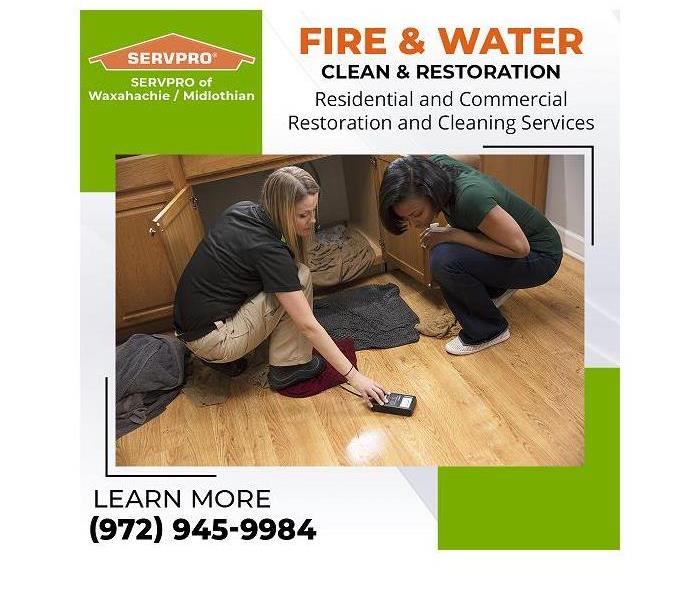 Here to Help
Here to Help
Blog Summary: SERVPRO of Waxahachie/Midlothian provides advice on dealing with water damage in the garage.
Water damage, fire damage, or other property damage disaster can strike at any time, causing stress and worry. SERVPRO of Waxahachie/Midlothian is the best choice for cleanup and restoration. The team’s arrival on the scene sends worry and stress packing.
Storage spaces in the home are susceptible to water damage. The damage can be severe because the leak often goes unnoticed for weeks or months. The unaddressed damage can lead to advanced secondary water damage, including mold infestation and structural damage to the affected areas. By the time the problem is discovered, floors, walls, and the stored items themselves have suffered extensive damage. The garage is a case in point.
For most homes in the Dallas area, the garage is the largest storage area found in the home. This space is versatile and can serve as a storage area, a home gym, an office, or a DIY working area. The garage does not receive the careful attention paid to the inside living spaces and is often overlooked when it comes to water intrusion and the damage it can cause. Yet, the cost of water damage in the garage and the impact on people’s health can be serious.
How to Identify a Water Leak in the Garage
Water leaks can cause a wide range of problems in the garage. Locating the source of the water is often complicated and confusing for the homeowner. Water can travel a great distance from its origin point to its final destination. Only a thorough inspection of the garage can turn up the source of the water. Here are some tips on spotting water leaks in the garage.
Search for cracks, crevices, and holes
Water can find its way into the garage through small holes and cracks. Crevices in the concrete function like veins that enable water to flow into the garage. Because concrete is naturally porous, cracks and holes may develop at any time. In some instances, insects can be the origin of these holes. These tiny holes in the garage become the point of entry for water. Homeowners should be aware that garages built below grade have walls that are more vulnerable to water pressure from the ground. Other potential entry points for garage water intrusion include pipes, electrical wiring, and cables that enter the garage through concrete or wood walls.
Pro Tip: Leaks can be prevented or stopped by sealing around pipes, wiring, and cables. Visible holes and cracks can be patched with hydraulic cement from the local hardware store. When water damage occurs in the garage, the professionals at SERVPRO of Waxahachie/Midlothian can restore and repair the areas damaged by water, including the reconstruction and repair needed to prevent further water damage.
Check gutters and downspouts
Gutters and downspouts are designed to capture water and direct it away from the foundation of a structure. If the ground does not adequately slope away from the garage, water can seep in and cause damage. Clogged gutters can overflow and deposit the water very close to the foundation. Even if the ground is well sloped, it can become too saturated, allowing water to seep through the foundation and into the structure, including into the garage.
Pro Tip: Keep gutters and downspouts unclogged. Extend the downspouts at least six feet away from the foundation. Some recommendations are that the slope away from the foundation should be six inches over ten feet.
Check the roof
Damaged shingles and flashing can allow water to leak into a garage. If the intrusion is hidden within a wall, the damage could result in mold infestation, wood rot, and damage to personal belongings. In some garages, the walls are hidden behind layers of stacked boxes, so a water leak and water damage may go undetected for years. The only clue to water damage may be the musty smell of a mold infestation. Finding and stopping the leak is the first step. Reconstructing portions of the damaged garage structure may be the next step after any mold issues have been resolved.
Pro Tip: Periodically inspect the roof for damage, especially after severe weather. Look for any signs of damage. Conduct a visual check of the ceiling and walls in the garage and the attic area above the garage. Wet spots, warping, and a moldy smell may indicate a water leak and some damage. Professional help may be needed to resolve any leaks and to repair the damage.
Inspect other potential leak points
Inspect joint seams. Seams that connect walls to the doors and windows are susceptible to leaks. The sill plate connecting walls to the concrete walls, foundation, and slabs can also invite water leaks.
Assess the humidity and condensation levels of the garage or any rooms or storage areas in the garage. A high level of humidity and condensation is a prime breeding area for mold. Mold thrives in warm, dark, and moist areas. Homeowners who suspect humidity and condensation issues anywhere in the home should contact the professionals at SERVPRO of Waxahachie/Midlothian who have the experience and technology to accurately diagnose any problems.
Pro Tip: Protect against water damage to belongings stored in the garage. Anticipate a worst-case scenario and take preventive measures.
- Employ shelving that keeps belongings from resting directly on the floor.
- Store items in waterproof containers.
- Seal the garage door to prevent flooding during severe weather from entering the storage area.
- Store items as far away from potential water sources as possible, including doors and windows.
Regular inspection and maintenance are the best strategies to prevent water damage in the garage. If water damage is discovered, look for mold damage, too.
SERVPRO of Waxahachie/Midlothian has been serving the Dallas/Fort Worth area since 2000. Being a local company, they are within a thirty-minute drive or less of any location in the community. Their specialties include residential, commercial, and large-scale disaster cleanup and restoration. Whether the disaster involves fire damage, smoke damage, or water damage to a garage, they have the expertise and experience needed to clean up and restore the damaged property.
For more information about water damage restoration in Waxahachie and Midlothian and other services, contact the office by phone at (972) 935-0827 or email acarey@SERVPRO10932.com.
Water Damage Restoration Company Explains How to Spot Hidden Water Damage
10/9/2020 (Permalink)
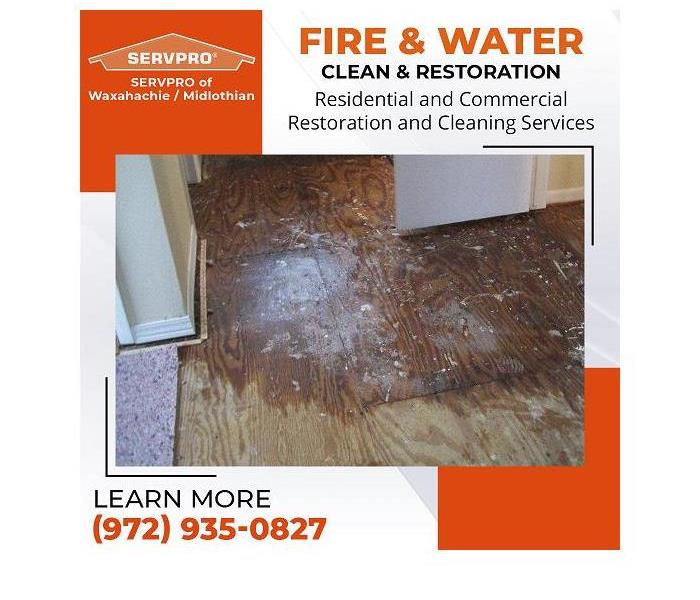 Here to Help
Here to Help
Summary: SERVPRO of Waxahachie/Midlothian offers tips on how to spot hidden water damage in a home or business.
The team of water damage restoration professionals at SERVPRO of Waxahachie/Midlothian understands how hidden water damage can lead to serious health problems and structural and cosmetic damage to a home or business. The consequences result in the need for extensive water damage restoration and, most likely, mold damage remediation. By the time the signs of a leak are noticed, the water damage has already occurred. A trained and vigilant eye, ear, and nose can detect signs of a water leak hopefully before too much damage has been done.
The Many Sources of Water Leaks
Understanding where some of the potential sources of hidden water leaks are will help the homeowner to spot signs of water damage. A typical home may contain dozens of possible leak points. Keeping a vigilant watch on these leak points can save thousands of dollars in water damage restoration and doctors’ bills.
Major Appliances Are Often a Source of Hidden Water Leaks
Five of the most common sources of water damage are:
- Washing machine
- Refrigerator
- Ice maker
- Dishwasher
- Garbage disposal
The Cumulative Effect of a Drop of Water
When a washing machine supply line ruptures, detection is almost instantaneous unless no one is at home to witness the disaster. As much as eight gallons of water a minute can flood into the laundry room. However, when a hot water connection leaks at one drop per second, over six gallons of water a day drip between the wall where the plumbing connections are located. Imagine the cascading impact of a leaking connection to the faucet in the kitchen, to the dishwasher, or to the ice maker. Slowly but surely, the damage compounds over time, rotting out the floor and causing a mold disaster under the sink, between the walls, and in the crawl space under the house.
The Mystery of the Leaking Fridge
The ice maker connection can create a major water damage incident if it bursts. When the line leaks unseen under the flooring is when real havoc can ensue. A partial leak could allow the ice maker to continue to function at a rate that appears to be normal while discharging several gallons a minute into the crawl space. When water is discovered coming from under the refrigerator, check the ice maker connection.
Usually, when a refrigerator leaks, the cause relates to a faulty seal. The faulty seal allows cold air to escape, causing the refrigerator to work overtime and producing more condensation on the coils than the system can eliminate. Fixing or replacing the seal can remedy the overproduction of condensation, which ends the pesky puddle of water on the floor. Adjust the refrigerator so that it tilts backward slightly, and the doors stay closed.
Nightmare in the Bathroom
Like clockwork, the bathroom daily fills with moisture. Condensation covers the floors, walls, mirrors, cabinets, and countertops. After an hour or two, the condensation mostly evaporates. The bathroom is a breeding ground for mold growth, and the battle against mildew is constant.
The tub and shower are prime suspects for hidden water damage. The tub and shower drains can leak for years without discovery, causing the floor to rot and creating a mold nightmare under the tub or shower and in the insulation and crawl space under the tub. One of the only ways to detect the leak is to crawl under the house, inspect the drain connections, test the insulation for moisture, and check for mold growth.
A hidden leak around the toilet can create an unsafe, unsanitary, and moldy mess. A tank that frequently recycles may give some hint of a leak in the system. There are occasional news reports about people falling through their bathroom floor due to water damage.
Five Key Signs of Hidden Water Damage
Hidden water leaks are all but impossible to detect until the damage is evident to the eyes, the nose, or the ears. Evidence of water damage includes the following signs:
- Musty odors
- Stains and discoloration on the ceilings, walls, baseboards, and floors
- Peeling paint and wallpaper
- Warping or buckling ceilings, walls, baseboards, and floors
- Visible mold
Vigilance Made Easy
These tips will help property owners remain vigilant without stressing over hidden water damage disasters.
- Look: Know where leaks are most likely to occur and keep an eye out. Review the five signs of water damage occasionally.
- Listen: In those moments when the house is calm and quiet, listen. Is there a dripping sound behind a wall, under a sink, or under the house?
- Sniff: Do a sniff test when returning home after being away for a while. The nose can become accustomed to persistent smells after extended exposure.
Turn to the Trusted Pros
If a suspicion arises that hidden water damage has occurred, reach out to the water damage specialists at SERVPRO of Waxahachie/Midlothian. They have advanced technology to locate the source of the water damage. Specially trained and certified technicians using the latest equipment can tackle any size water damage incident. Hidden water damage and mold infestation often go hand in hand. The mold mitigation professionals will apply safe, proprietary cleaning solutions, and they will use the latest mold mitigation equipment. SERVPRO of Waxahachie/Midlothian can handle all demolitions, repairs, and rebuilds. They also proactively coordinate with the insurance company so that the water damage restoration project can begin immediately and finish soon.
For more information about the Waxahachie water damage restoration company, contact the SERVPRO of Waxahachie/Midlothian office by phone at (972) 935-0827 or email acarey@SERVPRO10932.com.
Waxahachie Company Restores Water-Damaged Property
6/1/2020 (Permalink)
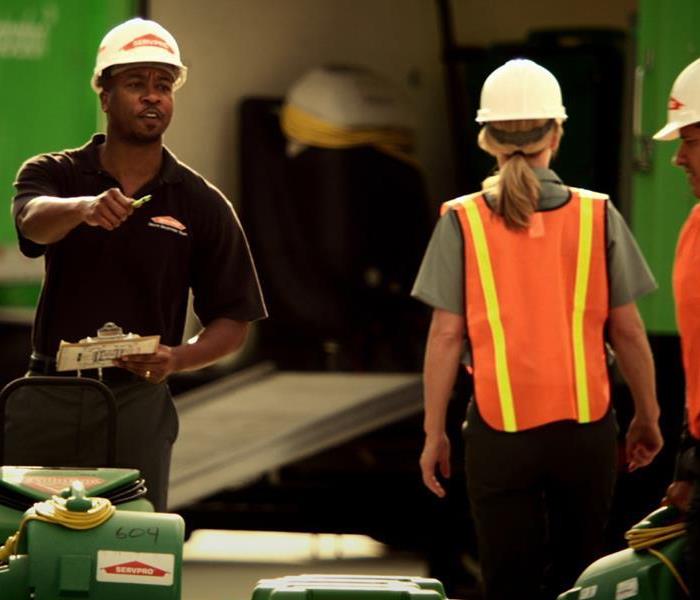 Here to Help
Here to Help
Summary: SERVPRO of Waxahachie/Midlothian restores water-damaged property with advanced technology.
According to Water University, a resource of Texas A&M University, “Healthy landscapes offer a variety of advantages for the home. They not only add aesthetic value but can also provide erosion protection, temperature control and serve as usable outdoor space for relaxing and entertaining. Oftentimes however, North Texas landscapes can be overwatered, over-fertilized or over-saturated with pesticides, which can be detrimental to water resources and your landscape. The EPA estimates that in dry climates like that of North Texas, a household’s outdoor water use can exceed the amount of water used for all other residential purposes! In some households, during summer, as much as 60% of a total water budget could be spent on landscape irrigation. By incorporating irrigation best management practices and by selecting the right plant material for your specific needs, you have the potential to drastically reduce water and chemical use in your landscape.”
After Jen read this article from Water University, she determined to capture the water from the HVAC system in a barrel and use it to irrigate her culinary herb garden. The water was perfect for the herbs because it would be pure. The twenty-plus gallons per day produced by a central HVAC system would be more than enough to water the thirsty herbs.
Meanwhile, Jen’s husband David had been wondering how to manage the water from the new HVAC system that was going to be installed next week. Most new systems tap into the existing drain system, but this additional water would increase the water and sewer bill. Besides, during the winter, when the condensate drainpipe was empty, noxious gases could enter the home from the sewer or septic tank. The float switch or the condensate pump could malfunction, causing severe water damage and mold if not caught very quickly. David had read of homeowners being on vacation for weeks only to return to ceilings, walls, floors, and carpets damaged by the HVAC drip pan leaking or overflowing.
When David heard about Jen’s idea, he was thrilled. He would install a float switch on the drain pan to turn off the unit in case of a clogged pipe, and the couple could enjoy the water from the HVAC system every time herbs and spices were harvested from the garden.
Why Choose SERVPRO of Waxahachie/Midlothian?
By the time that water damage from an overflowing HVAC drip pan is discovered, hundreds of gallons of water may have leaked all through the home, causing thousands of dollars in damage to the ceilings, walls, and flooring. Mold and mildew are likely involved.
When a Waxahachie home has water damage from flooding or leaks, homeowners need a water damage restoration company that can respond immediately and has the expertise and equipment to properly restore the property. SERVPRO of Waxahachie/Midlothian uses advanced water damage inspection and extraction equipment to help locate the moisture and remove it as quickly as possible. Cutting-edge drying equipment and proven techniques help restore a home more quickly and minimize cost. SERVPRO uses equipment that helps detect hidden moisture and extract standing water quickly and efficiently. Utilizing professional-strength cleaning, sanitizing, and deodorizing products brings comfort and safety to homeowners. The highly-trained technicians monitor and document the drying process so that homeowners can be certain the property is back to normal. Following the Water Damage Tips provided by SERVPRO protects both property and the property owner and family.
The Water Damage Restoration Process
Since every flood and water damage scenario is a little different, each one requires a unique solution tailored to the specific situation. However, the overall water restoration process remains the same. The steps below detail the restoration process for the typical water-damaged property.
Step 1: Emergency Contact
Step 2: Inspection and Damage Assessment
Step 3: Water Removal/Water Extraction
Step 4: Drying and Dehumidification
Step 5: Cleaning and Repair
Step 6: Restoration
Conclusion
With emergency 24-hour service, highly trained staff, and advanced inspection, extraction, removal, and drying technology and equipment, SERVPRO of Waxahachie/Midlothian is the best choice. The company is proud to serve local communities, including Waxahachie, Midlothian, Venus, Maypearl, Mountain Peak, Ward, and Ellis County.
To learn more about water damage restoration resulting from an HVAC leak or any other source, visit the SERVPRO Waxahachie/Midlothian website at https://www.SERVPROwaxahachiemidlothian.com. To speak with a SERVPRO representative, call (972) 935-0827.
Faster to your Ellis County Water Damage Event
4/16/2020 (Permalink)
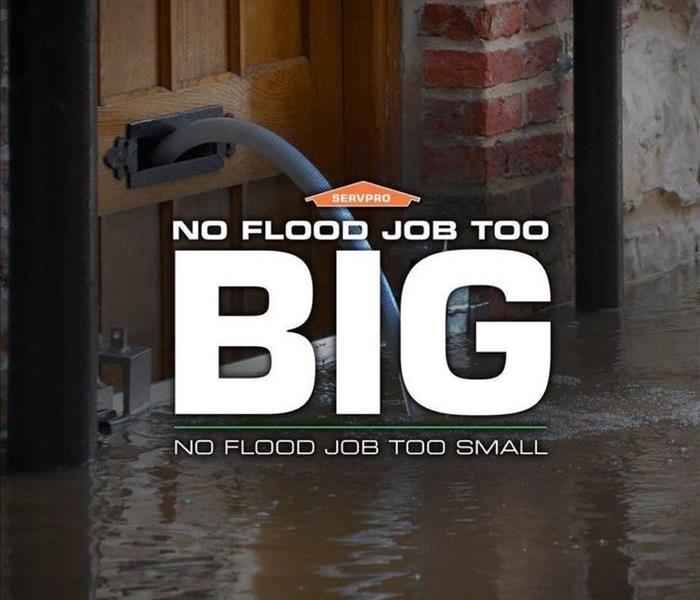 SERVPRO of Waxahachie/Midlothian provides 24 hour fire and water damage restoration service in Ellis County.
SERVPRO of Waxahachie/Midlothian provides 24 hour fire and water damage restoration service in Ellis County.
Flooding and water emergencies can happen at any time -- they don’t wait for regular business hours and neither do we. SERVPRO of Waxahachie/Midlothian is ready to respond to your water emergency 24 hours a day, 7 days a week—including all holidays.
Faster To Any Size Disaster
When you have a flood or water leak, water quickly spreads throughout your home and gets absorbed into floors, walls, furniture, and more. It is imperative to have a water mitigation specialist, such as SERVPRO of Waxahachie/Midlothian, arrive quickly and start the water extraction process almost immediately. This immediate response helps to minimize damage and cleaning and restoration costs.
Need Emergency Service? Call Us 24/7 – SERVPRO of Waxahachie/Midlothian 972-935-0827
Water Damage Timeline
Within Minutes
- Water quickly spreads throughout your property, saturating everything in its path.
- Water is absorbed into walls, floors, upholstery, and belongings.
- Furniture finishes may bleed, causing permanent staining on carpets.
- Photographs, books, and other paper goods start to swell and warp.
Hours 1 - 24:
- Drywall begins to swell and break down.
- Metal surfaces begin to tarnish.
- Furniture begins to swell and crack.
- Dyes and inks from cloth and paper goods spread and stain.
- A musty odor appears.
48 Hours to 1 Week:
- Mold and mildew may grow and spread.
- Doors, windows, and studs swell and warp.
- Metal begins to rust and corrode.
- Furniture warps and shows signs of mold.
- Paint begins to blister.
- Wood flooring swells and warps.
- Serious biohazard contamination is possible.
More Than 1 Week:
- Restoration time and cost increase dramatically; replacing contaminated materials and structural rebuilding may be extensive.
- Structural safety, mold growth, and biohazard contaminants pose serious risks to occupants.
About SERVPRO of Waxahachie/Midlothian
SERVPRO of Waxahachie/Midlothian specializes in the cleanup and restoration of residential and commercial property after a fire, smoke or water damage event. We are located in the heart of Ellis County, where we can reach your emergency in Waxahachie, Midlothian, Red Oak, Glenn Heights, Ennis, Corsicana, or any other Ellis County city within an hour. Our staff is highly trained in property damage restoration. From initial and ongoing training at SERVPRO’s corporate training facility to regular IICRC-industry certification, rest assured our staff is equipped with the knowledge to restore your property.
Certifications
ASD - Applied Structural Drying Technician
ECTP - Employee Certification Training Program
IICRC Certified Firm
RRRP - Lead-Based Paint Activities and Renovation
WRT - Water Damage Restoration Technician
Can I Dry My Home Flood Myself?
4/1/2020 (Permalink)
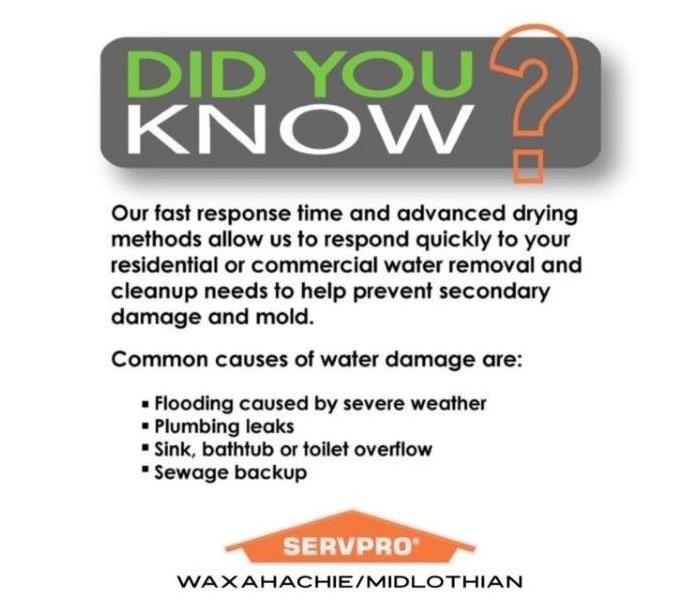 Our fast response time can save our customers from unneeded worry and potential secondary damage.
Our fast response time can save our customers from unneeded worry and potential secondary damage.
My bathroom has flooded! Can I clean it up myself?
Flood waters in the home often originate from plumbing in bathrooms (a broken pipe, clogged toilet, leaky shower enclosure) or kitchen areas (leak under sinks, dishwasher overflows, drain backup). When this happens, It might be tempting to mop the water up and put a fan or two on the wet area until it appears to be dry. No big deal, right? No - this approach can lead to more problems down the road.
You should always contact a professional, such as those at SERVPRO of Waxahachie/Midlothian and SERVPRO of Ennis/Red Oak to assist in the cleanup of a residential flood - to protect your family's health and to prevent further damage to your home. The professional will assess the quality of the water that flooded your home and the class of the water loss.
There are several questions to ask when a flood has occurred. First, what is the source of the water and what contaminants have been introduced into the flood waters? This will determine the quality of the water and affect many decisions in the drying process. Next, how long has water stood in the area and to what extent have structures and contents become saturated? This will determine the class of the water loss and influence decisions about what can be dried and what will be disposed of. And finally, how will you know when the area is truly dry, not just visibly, but inside walls, under carpets and pads, and throughout materials in the area? This is imperative in preventing further damage through subsequent deterioration and possible mold growth.
This article is limited to the first question above. It explains the importance of understanding the three quality of flood waters and how that determination affects decisions about the drying and cleanup process.
Understanding Quality of Water
There are three categories of water that can result in a residential flood - for example, from a toilet.
Category 1 (clean water) originates from a sanitary source. It poses no health risk when it comes into contact with skin, is ingested, or is inhaled. In the toilet leak example, if the water comes from the pipe behind the toilet, before the water has entered the toilet tank, it is originally Category 1 water. It is important to note the cleanliness of Category 1 water can deteriorate to Category 2 or 3 when coming into contact with other materials in the environment.
Category 2 (grey water) contains significant contamination and has the potential to cause discomfort or sickness if contacted or consumed by humans.
Category 3 ( black water) is grossly contaminated and can contain pathogenic, toxigenic, or other harmful agents. Such water may carry silt, organic matter, pesticides, heavy metals, regulated materials, or toxic organic substances. In the toilet example, toilet backflows that originate from beyond the toilet trap, regardless of the visible content or color, is considered category three water.
The category determination will greatly impact the way in which you or a professional team will approach the drying and cleanup process.
Class of Water Loss
There are 4 classes of water loss, depending on the magnitude of damage.
Class 1 is when only low-porosity and low-permeability materials in the area are affected. This means materials like linoleum, wood floors and fixtures, and tile.
Class 2 is when the water has affected an entire room or area, or multiple rooms in the house. This includes structures and up to two feet of water seepage up any walls.
Class 3 is when virtually all of the area has been saturated with the overflowing water. Ceilings, insulation, structures, furniture, cushions, carpeting, and more are affected.
Class 4 is when low-porosity, low-permeability materials like concrete, stone, and hardwood are saturated. Since the water can get caught in hard-to-reach pockets, they evaporate more slowly and require special techniques to dry.
Category 1 Cleanup Process
If the water is Category 1, then the focus becomes on extracting the water from the flooded area and placing equipment (fans and dehumidifiers) in the area, and monitoring the moisture in the area, until it can be deemed completely dry. Little emphasis needs to be placed on placing barriers between the wet areas/objects and the persons doing the work of drying things out. However, it should be noted that even the cleanest flood waters should be approached with minimal protective wear, such as rubber gloves. Materials that were affected in the flood, such as wooden trim, drywall, cabinets, carpet or other flooring, and furniture, can be dried out and left in the home for continued use. As long as the items were not structurally damaged to a point which would deem them unsalvageable, there is no need to remove them from the home. That is, they do not pose a health risk.
Category 2 Cleanup Process
When a home flood involves Category 2 water, the persons entering the flooded area must first take precautions to protect themselves from contaminants while working in the area and handling affected materials. Protective equipment such as rubber boots that can be disinfected and rubber gloves will be worn at all times. They might also choose to wear a face mask and googles if the cleanup process is to the extent that moving contents and other actions might cause splashing of flood waters. In this case decisions will be made about materials and items in the affected area based on how porous they are, whether they were saturated with the flooded water, and whether they can be effectively disinfected and left in place after the drying process. For example, where a carpeted area is affected with category 2 water, the carpet can be cleaned, dried, and disinfected; however, the carpet pad beneath must be removed and disposed of. Other hard surfaces can be cleaned, dried, and disinfected, as well.
Category 3 Cleanup Process
Category 3 flood waters pose a high risk of causing illness in persons, so this type of flood requires extreme measures during the cleanup process. This type of flood can be caused by something as common as a clogged toilet over-flowing or a clogged shower drain allowing sewer water to backup into a home. In this case, professional will wear full personal protective equipment. Not only rubber boots that can be disinfected and rubber gloves, but a full disposable body suit that protects skin and clothing from contaminated waters and materials must be worn, as well as a respirator and protective eye googles. They will set up a decontamination area to be used when moving from the contaminated area into the uncontaminated areas of the home. I addition, any porous materials in the area must be removed and disposed of as they will have absorbed pollutants from the contaminated water. That means baseboards and drywall that were saturated with flood waters must be cut out and removed. Carpet and carpet pad must be removed and disposed of. Upholstered furniture that was affected must be disposed of. In other words, an item by item determination will be made as to whether household items can be effectively cleaned and disinfected or if they will be disposed of. Leaving Category 3 contaminated materials or items in the home can pose dangerous health risks to residents.
Leave the Cleanup to the Professionals
You can see why it is best practice to leave the cleanup process after a flood to the professionals, such as those at SERVPRO of Waxahachie, Midlothian, Ennis, Red Oak - serving all of Ellis County. Call us at 972-935-0827. We have the training and experience to determine the level of risk involved with flood waters. We have the trained personnel and professional equipment to quickly extract waters and get the drying process complete in the shortest amount of time, saving you money and reducing the risk of complications from an improperly dried home. We strive to truly make it "Like it never even happened."
Advice During your Water Damage
2/19/2019 (Permalink)
There are some small steps you can take to ensure that your water damage dries as quickly and hassle-free as possible. We will be coming every day to monitor the equipment and check on the drying, but in between those visits are 24 hours where the actual drying occurs.
First, our technicians place our equipment in strategic locations for your benefit. We will try to create a cylinder of airflow that leads back to the dehumidifier to maximize the effectiveness of our drying equipment. Therefore, we ask that you do not move or reorient the machines if at all possible. We understand that at times the optimal placement is in a location that is inconvenient. If machines do need to be moved, please place them as close to their original position as possible to maintain the airflow we were hoping to accomplish.
Next, it is important that if the water damage is in a single room and our technicians close the door to that room it is because it will help the drying process immensely if the room is contained and the air in that room is constantly cycling through the dehumidifier. For this reason, we ask that any rooms with equipment remain shut if possible. These rooms will probably be slightly warmer than the rest of the house, which is a good thing. Warmer temperatures allow for more condensation to transfer into the air, and makes it easier to remove via our dehumidifiers. While we don’t expect you to live in persistent heat, it would be beneficial if the temperature in your home were raised a few degrees to promote quick drying.
However, the number one thing that you can do to ensure a quicker drying time is to let the machines continue running. While there are a couple of things that you could do to help the drying of your floors and walls, there is one thing that many customers do that will harm our drying attempts. That is, of course, turning our machines off. Some customers, depending on the amount and location of our equipment, find them to be too loud and a nuisance during their daily lives. While we strive to be as minimally invasive as possible during our water mitigation, sometimes with equipment placed in living rooms and kitchens, there is no way around it. The worst thing someone can do it to turn off our equipment.
Keeping in mind that these air movers and dehumidifiers are being rented by you, the customer, it is simply a waste of time and money to turn off the machines. These were designed for and work best when they are allowed to run continuously until the affected material is dry.
Our biggest advice to you is to let the machines do their intended work, and hopefully, we can dry your home and have everything picked up and back to new before you know it!
Written by: Brendan Gillette
Different Types of Water Damages
2/19/2019 (Permalink)
Not all water damages are created equal. In fact, beyond the various sizes and severity of water damage you have, there are 3 distinct categories that we use to differentiate water damage based on the source of the water. It is important to understand the different categories because this has a direct effect on the work we perform in your home or property.
Category 1
Category 1 water damages, shortened to Cat 1, are water damages that involve completely clean water. A rule of thumb for this water damage is water that is perfectly fine to drink. This could come from a busted pipe underneath the sink, a failed supply line, or any other source of water that is free of contaminants. This water is the easiest and fastest to clean, however, expediency is still necessary for this category can turn to category 2 as quickly as 24 hours after the damage occurs if not properly handled.
Category 2
Category 2 water damages have what we consider a small number of contaminants. These are the result of washing machine leaks, dishwasher leaks or overflows, sump pump failure, and many more. This water is generally grey in color, can contain chemicals as well as bio-contaminants, and while it should not be consumed by any means (no water that is on your floors should be!), it poses a small health risk to those exposed to the water for a short time. These contaminants will require that we properly sanitize the affected areas to prevent the situation from getting worse. Similar to category 1 turning to category 2, if left untreated this category can escalate rapidly into a much more hazardous situation.
Category 3
Category 3 water damages are classified as the worst type of water. These are completely unsafe to be near and contain many contaminants that you will want to be cleaned properly and quickly. Examples of this include, but are not limited to, toilet backups that include waste and flood waters bringing contaminants from outside your home. These are serious health risks, and often they require what we call a ‘flood cut’. This includes removing floors and drywall up to 2 feet up to ensure no contaminated materials remain. The nature of the source requires the use of Proper Protective Equipment to clean, and multiple applications of sanitization.
Knowing about these categories is important should you have water damage so you understand the different steps we are taking, and why they must be taken. We do not expect you to become an expert at recognizing the intricacies of each category, but basic understanding can go a long way when you are explaining your water damage to our dispatcher.
SERVPRO of Ellis County is here to help no matter the category, no matter the time, and no matter how large.
We are ready to make your property like it never happened!
Written by: Brendan Gillette
Insurances and Water Damages
2/19/2019 (Permalink)
If SERVPRO of Ellis County isn’t your first call when you come home to discover the water heater has burst, then it is probably to your home insurance.
We work with various insurance companies, and in doing so have experience working with all types of adjusters and requirements to complete your job in a satisfactory manner.
It is important to be aware of a few things regarding insurance companies so you can efficiently navigate the often confusing world of water damages.
Forms and Paperwork
There are a few forms that need to be signed prior to beginning your water damage. These outline the expectations and protect all parties involved during the process.
Our forms include Authorization to Perform Services and Direction of Payment which is an agreement to perform water mitigation and also an agreeing upon who will be the paying party.
There is the Equipment Rental Agreement simply outlining that you will take care of (you can simply not touch it and be fine) the equipment that is rented and left on your property.
Finally, we have a Customer Information form that is simply gathering the best contact information and information regarding your house so we here in the office can contact you.
Your insurance, however, depending on who you are insured with, may have their own version of these forms and may have further forms that are required before we can start the job.
We understand you are anxious to begin mitigation services, and understanding these necessary forms is a huge step in expediting the process so we may begin.
Estimates and Pricing
When we are doing your water damage, you or your insurance may want an update on what the total costs are going to be. This is especially true if demolition is required and there will be a rebuild in the future.
A lot of factors go into the estimate and approval process when your job is going through an insurance agent/adjuster. At the end of the day, almost all demo and rebuilds have to first be approved by your insurance adjuster before we can begin this work. We do our best to get this all done in a timely manner by the ever-helpful administrators here in the office, but at times this may cause a slight delay in your job until we manage to get approved.
Sometimes the adjuster requires they be onsite to do measurements and observe the damages themselves before work can be approved. Sometimes adjusters need time to look over our estimates before they approve them. All of these are facts of life that we work with in order to complete your water job as soon as we can.
In regards to pricing and payment, insurance companies handle these in different ways. Some will send the agreed upon amount minus your deductible to you, the homeowner, and we will collect the payment from you directly. Others will mail us the check and require us to collect just your deductible. Even others will mail us the entirety of the payment and collect the deductible from you themselves.
Whatever the situation is, we will remain in contact with you and the adjuster to make sure we are all in agreement about the final bill.
Should you have a question regarding payment status after your job, the best person to contact is your insurance adjuster and ask them for that status.
Written by: Brendan Gillette
What you need to know about water damage
2/10/2019 (Permalink)
Let’s discuss the basics of a water damage. This information is useful for anyone who rents or owns property, seeing as a water damage could happen at any time. We’ve written other more specific blogs about different types of damage and different scenarios that you may face. For now, we are going to go over just the basics.
What is Water Damage?
Water damage is a term used to describe damages to your floors, walls, ceiling, and contents caused by an unintended intrusion of water. There can be many causes of water damages, which we will go over, but first, we must establish exactly what is and is not considered water damage.
You do NOT have damage if:
- Your daughter gets the floor in the bathroom wet after a shower.
- You spill a glass of water on the carpet in your living room.
- You accidentally splash water on the kitchen cabinets and floor while doing the dishes.
In these instances, you can simply clean the affected area and wipe up all moisture that is spilled. This doesn’t require a professional. Simply get a towel and you are good to go!
You DO have damage if:
- Your bathtub was left running, leaving an inch of water standing in your bathroom.
- A pipe underneath your sink broke, and you didn’t notice for hours.
- Your hot water heater leaked or burst, emptying its water inside your home.
- Water is accumulating somewhere in your house but you are not sure of the cause.
There are many more potential causes, but the point here is that you cannot simply use a towel to soak up these problems. If you do find yourself in a situation where your hot water heater burst, you might be presented with more water than you thought was inside your house now spilling across your living room, kitchen, or any room in your house.
This is, understandably, a frantic and alarming thing to happen, but our team at SERVPRO of Ellis County sees these cases and much worse on a daily basis and we are ready to help!
A good rule of thumb: if you are not sure whether your water emergency requires the assistance of professionals is it is better to be safe than sorry.
Give us a call at (972) 935-0827 and we can come to do a moisture check for you and find out if the extent of moisture is enough to require professional assistance.
Read our next topic:
Why do you need to have your water damage addressed?
Why You Need Water Mitigation Services
2/10/2019 (Permalink)
After getting a clear understanding of what constitutes water damage, your next thought may be, “Okay, but why do I need to hire someone to do water mitigation?”
This is an understandable line of thought, and we’ll shed some light onto the necessity of the services we provide here at SERVPRO of Ellis County.
We Perform Water Mitigation Services
When we dissect what it is we do, the purpose and need for water mitigation become clear. We mitigate further damages, further problems, and as a result, mitigate further costs.
Being a liquid, water has a tendency to spread and seep into more items, walls, and floors the longer it is left unattended in your home. What might have started out as a small water heater closet getting soaked can, unheeded, travel through walls, into other areas of your home damaging floorboards, drywall, and insulation in the process.
It goes without saying, there is a need to stop the spread of water and mitigate the potential damages when you are faced with water damage. Left unchecked, water damages can buckle floorboards, soak carpet, and require complete removal and replacement of flooring and walls.
Luckily, SERVPRO of Ellis County is available 24/7 with crews ready to respond to your emergency in a timely fashion and begin mitigation work before a small water damage becomes a large one.
Growth: An Unwanted Visitor
Another key reason we strongly recommend water mitigation is because of the potential of growth.
Cold, wet, damp locations, such as those found beneath your floorboards, and inside of your drywall when you leave areas wet, are the perfect scenario for the growth of mold and other potentially harmful substances.
We see unmitigated water damages turn into a completely avoidable amount of growth very quickly. Unfortunately, the protocol for safe removal of growth can be much more costly than the initial water mitigation, and the price of not doing so is a potential health hazard to you and your family.
Our goal for your water damage is to mitigate the spread of water and dry all affected material to a suitable level without doing any demolition, but if the problem is allowed to turn into a growth remediation, there is little hope to fully remediate the growth without having to cut into drywall and dispose of affected material.
These are two of the largest reasons you need to have your water damage properly mitigated through the services of professionals like SERVPRO of Ellis County.
For your own safety, cutting corners is not an option when dealing with water damages inside your home or business.
Next, we will be discussing the specific work we perform when we are called out to handle your water damage.
What SERVPRO does during your water damage
2/10/2019 (Permalink)
Now that we have established what water damage is, and why it is necessary to have SERVPRO of Ellis County come to do the water mitigation, it is important to take a look into what work we will be performing to better familiarize yourself with the world of water mitigation.
First thing is first
The first thing we do is get an accurate picture of the affected areas. After extracting any standing water, we use moisture readers to measure the moisture content in your floors, walls, ceiling, and whatever else might be affected by water damage.
Our trained technicians have seen a myriad of different damages ranging in size and source and can get a basic understanding of your damages after a short time reading the moisture inside your affected and non-affected areas.
Keep in mind, you may not be able to see or feel that any surface is wet, but inside your floorboards or behind your drywall, there may be moisture trapped there that can cause more problems down the line.
Once we have a clear picture of the water damage at hand, we plug our readings and measurements into proprietary software to accurately gauge the drying requirements. This allows us to easily and automatically know how much equipment we will need to place.
Drying equipment
Now that we understand how much equipment needs to be placed for proper and expedient drying, the next step is to unload all required equipment from our trucks and place them in your house.
Water damages require the use of dehumidifiers and air movers. A dehumidifier is self-explanatory; we use industrial grade dehumidifiers to suck the moisture content out of the air, the very same air that comes into contact with the affected surface and attempts to reach an equilibrium between the wet material and dry air, removing some of the moisture that then gets fed back into the dehumidifier.
Our air movers are placed strategically around the room to create a circular vortex of air flow. The natural air flow combined with intentionally feeding air into dehumidifiers works in tandem to greatly assist the drying process.
Once our equipment has been placed, we must leave it running around the clock for the best results.
Then, the next step to do is monitor our equipment and the drying process. Our technician will ask when you will be available for an equipment check the following day, and we will arrive within a 30-minute window in order to take new moisture readings and assess how the floors, walls, and any affected area is drying.
Our typical jobs require 3-5 days of drying to reach acceptable levels of moisture.
When equipment doesn’t quite do the job
I wish it were as simple as place equipment and wait a few days, however certain circumstances may not allow us that luxury. If, for example, the affected drywall remains wet and doesn’t show an indication that it will dry, we might have to pull the baseboards off and drill holes in the wall to allow proper ventilation.
If wooden floors are buckling from water damage when we arrive on site, or if they are so saturated with water that our best efforts will not sufficiently dry them, they will have to be removed.
Certain material, such as sewage, is categorized as a Cat 3 water damage, and any affected areas must be replaced.
All of this falls under the term ‘demo’ and is sometimes a necessity. Do not worry, however. Whatever wall or flooring we have to remove, we will be able to rebuild for you and make it, “Like it never even happened!”
With the general water damage proceedings understood, the next thing to do is take a look at the different types of water damages and explain what they mean for you.
Keep a lookout for our next blog about the different water damage categories!


 24/7 Emergency Service
24/7 Emergency Service
